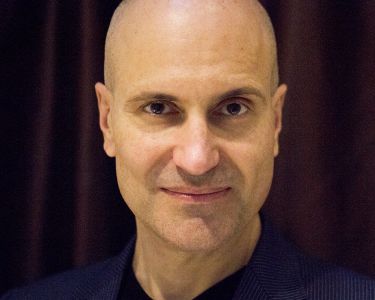
Human-Machine Interfaces, intelligent systems and cultural heritage
Maria Giulia Losi, PhD, Project Leader and Interaction Designer at RE:Lab; Silvia Chiesa, PhD, Project Manager in the R&D group of RE:Lab; Annalisa Mombelli, R&D group of RE:Lab, Reggio Emilia
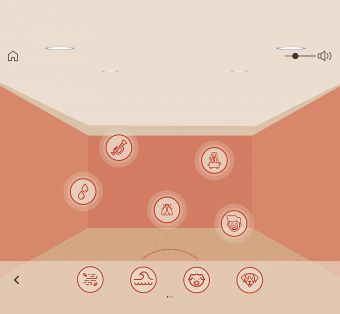
Human-Machine Interfaces, intelligent systems and cultural heritage
Perception might be reality
In today’s context, related to health emergency, some aspects of technological design assume a peculiar role. The first is the theme of distance; the second is the theme of the extension of sensory capacity through digital technologies; and the third is the recognition of the state of the subjects. These three sets of factors, the need to manage distance, the need to extend technological sensoriality into the distance, and the need to recognise in the distance not only the sensoriality but also the state of the user—whether a patient, driver or viewer—thus constitute a new axis of technological design.
Picture left: Interfaccia suono, Copyright: RE Lab
A new anthropocentric setup for technologies
This new axis prefigures the attempt to fill the gaps, the attempt to relaunch an idea of technology that can bring people together, even in this current social framework of difficulty. Therefore, starting from this idea of rapprochement, a new anthropocentric approach to technological performance can be founded, which is undoubtedly one of the central axes of a New Renaissance, based on the integration between the anthropocentric culture of the Renaissance tradition and the potential 4.0 of the technologies mentioned above: those intended to extend the sensory framework; those intended to increase the recognition of the subject and respect of his emotional and cognitive state,; and finally those oriented to extend his ability to live experiences not necessarily in presence.Starting from this premise, RE:Lab, in the framework of the activities of the Emilia Romagna Region, wanted to compose this complex puzzle with diversified initiatives within several projects. First of all, in the midst of the pandemic, the experience of restitution of a phenomenon of intense bodily relations such as dance was sought. Subsequently, the idea of extending the sensory capacity in the relationship, born even before the health emergency took shape, was resumed and developed, and then relaunched during the pandemic experience through the concept of an Atelier, that is, a creative space that takes into account the management of sound manipulation. Finally, we added the idea of including in the processes of technological relations the recognition of the state of the user, not only cognitive but also emotional, so that his emotions allow to recognise the state of use and on the basis of this to orient and design systems of safer and more effective interactions.
A Living Lab for Novel Human-Machine Interactions – A New Grammar for Dramaturgy and Choreography in Digital Space
How can user experience design foster innovation processes in the dance and live performance sector?In a historical moment like the current one, where distance has become one of the hallmarks of experience, the performing arts and dance sector has been put to the test. At the beginning of 2020, the Aterballetto Dance Foundation asked itself some questions:
– Can the emotion of the performance exist without the performance?
– Is it possible for a dance performance to engage the viewer while the dancer is not physically present?
– Is there a safe-conduct to ensure that art can express its expressive power in the absence of contact and in the presence of „distancing“?
In the most uncertain months of 2020, marked by the closure of theatres, the Aterballetto Foundation has managed, through the project Virtual Dance for Real People1, in collaboration with RE:Lab, to imagine a different user experience, through the techniques of Cinematic Virtual Reality and the use of virtual reality visors (such as Oculus Quest).
The design of the user experience has led not only to the creation of a new format for viewers but also to the formulation of a new grammar involving choreographers, interaction designers, and video experts, in identifying a common language and a new way of thinking about choreography. The spectator in fact has been imagined in a central position, in which the viewer can dance together with the dancers.
The search for a relationship of closeness with the spectator has led us to investigate the immersive aspects of technology, also through the use of spatialised sounds, without making the dance abstract: the choreography, conceived for the final technological instrument, remains at the centre of the experience, able to release new and unexpected emotions.
Picture right: MicroDanza Meridiana, Fondazione Nazionale della Danza / Aterballetto, Coreografia: Diego Tortelli, Danzatrici: Casia Vengoechea, Annemieke Mooji, Foto Celeste Lombardi, Technological development and user experience design RE:LAB
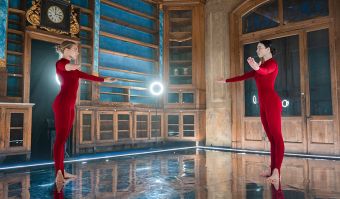
Dynamic Mapping—Sound Atelier in distance environments
Many studies have analysed how much music and the sound environment that surrounds us can influence cognitive and linguistic development.How can we investigate, through new immersive audio technologies, the relationship between children and sound, considered as a compositional element of musical language but also of language itself?
From the encounter between engineering research in the area of the spatialisation of sound and the mission of Reggio Children (International Center for the Defense and Promotion of the Rights and Potentialities of All Children), the Sound Atelier2 was born, a laboratory in which children can experiment with a new and complete concept of sound fruition, for which the new child-friendly application EUPHONIA was designed.
The design of the user interface was developed for and with the children, who were involved as design partners to verify their understanding of a 3D interface. In fact, through the support of the figures of the atelierista in collaboration with the designer, it was possible to highlight the difficulties that children had to orient themselves in a virtual environment and a new UX design was redefined for the tablet application called EUPHONIA from the union of the ancient Greek words EU (true) and PHONIA (sound). The app’s interface reproduces the room that houses the atelier in order to give the user an idea of the position of the sound in the space. From a dynamic acoustic library it is possible to choose sounds, associated with representative images, and position them in the space, thus composing 3D soundscapes.
Technological-pedagogical research on sound in space has thus taken its most natural form as the „Atelier of Sound”, an immersive audio environment/laboratory in which children can experiment and dynamically explore the entity “sound“ in all its dimensions.
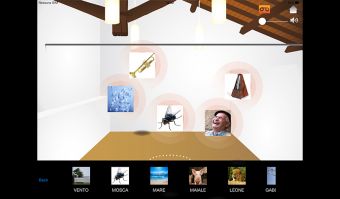
On the one hand, therefore, it is an expression of the Reggio Emilia Approach, a socio-constructivist educational philosophy based on research and the values of lifelong learning that strongly believes in the dialogue between theory and practice, and sees the child in his relationships with others, as an active part of the learning process. On the other hand, the interest of the multidisciplinary research group in the rendering of sound spatialisation has also approached the concepts of Acoustic Ecology described by the teacher/composer Murray Schafer in his great work The tuning of the world (R.Murray Schaefer, 1985): The soundscape is our acoustic environment, the ever-present noises we all live with. The author suggests that today we suffer from acoustic overload and are less able to hear the nuances and subtleties of sound. Our task, he argues, is to listen, analyse, and make distinctions despite the noise pollution.
The result of this Audio Interaction Lab is a dynamic 3D sound scene whose content and spatial organization is controlled in real time by the children, enhancing their awareness and sensitivity of sound in space.
Picture above: Euphonia, (particolare dell’App, schermata dell’ Area ambiente sonoro), progetto Atelier del suono/Reggio children, Technological development and user experience design RE:LAB
Spillover effects of Sound Design: Increasing driving safety and comfort through the recognition of one's emotional state: from the HU-DRIVE experience to the NextPerception project
Sound Design and its value-added in Human Machine Interaction are not limited to the Cultural and Creative Sectors and Industries—for illustration we review one project in the automotive sector: Several studies in the literature show a strong relationship between emotions and traffic accidents. In fact, negative emotions, such as fear, anger, disgust, or sadness, increase the likelihood of exhibiting dangerous behaviours while driving (Magaña et al., 20203).
In recent years, affective technologies have been developed that offer new opportunities to improve road safety by using the recognition of the driver’s emotions and state, and their regulation through appropriate interaction strategies on board the vehicle. Affective user interfaces are those interfaces that are capable of understanding through psychophysiological measures, conversational analysis, and facial expression recognition human emotions while interpreting, adapting, and potentially responding appropriately (Braun, Weber, & Alt, 2020).4
Within the HU-Drive5 project, the HUman Driver Assistance System presented at CES 2021 in collaboration with the startup Emoj, RE:Lab presents an innovative solution to increase safety, quality and comfort of driving. The HU Drive system, in fact, automatically recognises the driver’s emotional and cognitive state and adapts the vehicle interface in real time.
Novel Human-Machine Interactions based on trust and transparency
Recently, new trends are emerging in the topic of human-computer interaction. In order to achieve better levels of trust in automation, the „negotiation-based“ interaction approach has been studied (Koo et al., 20146; Castellano et al., 2018)7 which consists in providing the user with explanations instead of warnings, in order to increase the transparency of the system.
Taking this line of research as a basis, RE:Lab is carrying out the activity of developing an interface able to adapt to the state of the driver within the NextPerception project. The main objective of the project is to develop a Driver Monitoring System, able to classify both the driver’s cognitive states (distraction, fatigue, workload, drowsiness) and his emotional state (anxiety, panic, anger) as well as the driver’s position inside the vehicle. What can we learn here about the role of culture in digital societies and take spillover back to Cultural and Creative Industries?
In conclusion, RE:Lab’s research activity focused on the design of innovative strategies of interaction with emerging technologies, including artificial intelligence systems that do not want to replace people but put users, at best humanism, at the centre stage to amplify human capabilities.New conceptual models, new strategies, new metaphors will be born in future research about man and machine interaction, making the user more aware of what happens when interacting with these systems, and which are the expression of an interweaving between science and art, technology and cognitive and emotional languages: all elements at the basis of the redefinition of a New Contemporary Renaissance.
References
1 Trailer VIRTUAL DANCE FOR REAL PEOPLE (2021): https://youtu.be/h9u1Cs2GMf8
2 Federica Protti, Simone Fontana, Elena Maccaferri, Claudia Giudici, and Roberto Montanari. 2013. Audio-interaction lab: designing an immersive environment to explore the acoustic ecosystem with a tablet interface. In Proceedings of the Biannual Conference of the Italian Chapter of SIGCHI (CHItaly ’13). Association for Computing Machinery, New York, NY, USA, Article 19, 1–8. DOI:https://doi.org/10.1145/2499149.2499160
3 Magaña, Víctor Corcoba, et al. „The effects of the driver’s mental state and passenger compartment conditions on driving performance and driving stress.“ Sensors 20.18 (2020): 5274.
4 Braun, M., Weber, F., & Alt, F. (2020). Affective Automotive User Interfaces–Reviewing the State of Emotion Regulation in the Car. arXiv preprint arXiv:2003.13731.
5 EMOJ & RELAB present HU-Drive @CES2021, the innovative solution presented at CES 2021 by EMOJ and RE:Lab: https://www.youtube.com/watch?v=SQ_EWRAM23o
6 Koo, J., Kwac, J., Ju, W., Steinert, M., Leifer, L., & Nass, C. (2015). Why did my car just do that? Explaining semi-autonomous driving actions to improve driver understanding, trust, and performance. International Journal on Interactive Design and Manufacturing (IJIDeM), 9(4), 269-275.
7 Castellano, A., Landini, E., & Montanari, R. Un nuovo paradigma di interazione per la guida cooperativa: il progetto AutoMate.
Maria Giulia Losi
Maria Giulia Losi, PhD in „Humanities and Technologies: a research integrated path“. She is a project leader in RE:Lab with many years of experience in the design and development of Human-Machine Interaction systems and EU research projects. At RE:Lab since the beginning of 2011, she has been involved in several projects as Project Manager and Interaction Designer in different domains, from Automotive and Off-HIghway vehicles HMI and IoT Apps to Cultural Heritage interactive exhibitions design. Key publications are reported in the following:
1. Leandro Guidotti, Maria Giulia Losi, Roberto Montanari, Francesco Tesauri, “Motorsport Driver Workload Estimation in Dual Task Scenario”. IARIA Cognitive 2011
2. Daniele Pinotti, Fabio Tango, Maria Giulia Losi, Marco Beltrami. “A model for an innovative lane change assistant HMI”. HFES 2013 Conference Proceedings
3. Corazza F., Snijders D., Arpone M., Stritoni V., Martinolli F., Daverio M., Losi M.G., Soldi L., Tesauri F., Da Dalt L., Bressan S. „Development of a tablet app to optimize the management of pediatric cardiac arrest: a pilot study“. IPSSW2020 – 12th International Pediatric Simulation Symposia and Workshops
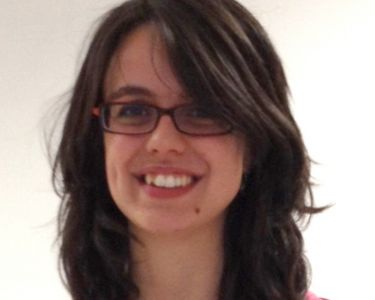
Annalisa Mombelli
Annalisa Mombelli, Graduated with a Master’s Degree in Conservation of Cultural Heritage at University of Parma, defending a thesis about the innovation in publishing by Bodoni with his illustrated masterpiece “Epithalamia”. She also graduated in Advanced European Studies at European College of Parma. She worked as a freelance coordinator for private and public cultural projects. Now, she works in the R&D group of RE:lab, following activities in the field of education and culture.

Silvia Chiesa
Silvia Chiesa, PhD in Psychological, Anthropological and Educational Science at the University of Turin, defending a thesis concerning the spatial cognitive abilities in disabled persons. She expanded her activities outside the academic field working in the context of Human-Machine Interaction and more in general in the User Experience Research. She is Project Manager in the R&D group of RE:Lab. Here, she led international projects and activities concerning usability and acceptance assessment, in the domains of transports, household appliances and healthcare.
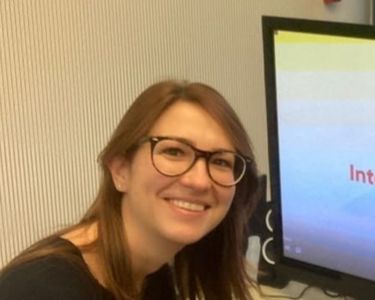
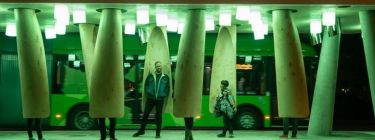
From the Station of Being to Societal Transformation – How design can drive a new European Renaissance
Ambra Trotto, PhD; Prof. Caroline Hummels; Jeroen Peeters, PhD; Daisy Yoo, PhD; Professor Pierre Lévy Eindhoven University of Technology, National Conservatory of Arts and Crafts
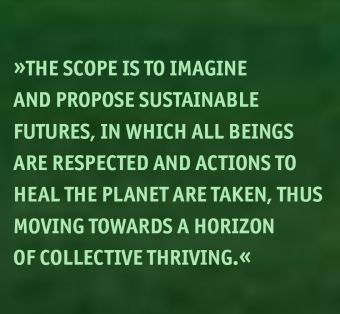
The design and how it came to be
The ‘Station of Being’ is a fully functional, experienceable prototype of a Smart Bus Station in the Northern Swedish city of Umeå that was opened in 2019. The project was initiated by the City of Umeå and partly funded by the H2020 Smart City Lighthouse project RUGGEDISED.
The aim of this design is to make public transport more attractive, to promote an increase in use and, in turn, to lower the carbon emissions of the city. The Station achieves this by affording a positive waiting experience, aiming to turn wai(s)ting time into time to feel, reflect, pause and move: in a nutshell, to be.
Two main components of the design contribute to the passenger’s experience.
– A dynamic light and soundscape informs passengers in or near the station which bus is about to arrive. A subtle play of lights refers to the arriving bus line through its colours, while a soundscape plays to tell stories about the character and history of the line’s final destination. This combination offers ambient information which can be perceived on one’s sensorial periphery, removing the need for passengers to pay constant attention to the coming and going of busses.
– Wooden ‘pods’ hanging from the ceiling provide a physically comfortable place for waiting passengers and contribute to a feeling of safety. The pods can be turned 360 degrees, providing a way to lean and stay out of the wind or just mindlessly sway. The pods allow one to seclude oneself, or to create a social space.
Picture above: Station of Being, Copyright by Samuel Pettersson
The design and development process for the Station of Being followed the Designing for Transforming Practices approach (Hummels, 2021, Trotto et al. 2021), which catalyses liveable ecosystems by transforming existing practices into truly sustainable ones through design. It does so by initiating and curating multidimensional synergies, driven by beauty, diversity and meaning. The scope is to imagine and propose sustainable futures, in which all beings are respected and actions to heal the planet are taken, thus moving towards a horizon of collective thriving. Those futures are populated by people living purposeful lives, in beautiful living spaces.
The design process of the bus station involved a large number and a wide range of stakeholders. The project was driven by the national Swedish research institute RISE in collaboration with a design and engineering consultancy, Rombout Frieling Lab. The project was owned by the Comprehensive Planning Department of the City of Umeå and the Streets and Parks Department acted as a client. The process further involved the Umeå Institute of Design at Umeå University, the public transport company Ultra, the local energy company, Umeå Energi, real estate developers, maintenance workers and engineering and building companies.
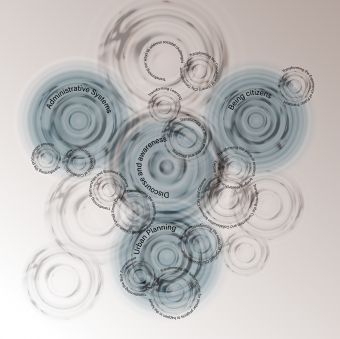
Elucidating transformations
Transformation is a substantial change, often associated with innovative and radical change. Transformation occurs when one configuration is converted or changed into another, whereby the change is major or complete (Mirriam Webster Dictionary). We use the term ‘transformation’ when designing for transforming practices (TP) to denote substantial enduring change of values, ethics, and related behaviours of a person, a community or society, triggered by the need of creating alternative ways to engage with the world, addressing specific societal challenges. In this context, people and communities become (and are) transformation itself. This demands a leap, a paradigm shift, even for what seems to be smaller personal transformations (Hummels et al., 2019; Hummels, 2021, Trotto et al. 2021).
Picture right: Copyright by Ambra Trotto, Caroline Hummels, Jeroen Peeters, Daisy Yoo and Pierre Lèvy
The process that led to the development of the Station of Being spans from the inception of a procurement process in 2017 for its construction to today being a functioning bus station in Umeå. This project triggered different levels of societal transformation grouped around four types of practices, as shown in the figure below. We saw transformations emerging in administrative practices related to the organisational and legal activities and procedures of all parties involved. Moreover, the Station of Being has brought about several transformations in the way one can be an active and engaged citizen, and in the way one can be a responsive municipality and community,
particularly in the domain of urban planning. Finally, it has changed the overarching discourse on how to research, develop and transform smart cities and communities.
Some of these transformations were explicitly intended, some of them emerged unexpectedly along the way and had an impact on the process, and some are indirect consequences of the process that we observed over time. We will elucidate these four practices, by unpacking one illustrative example each, regarding transformations at different levels and scales of the process.
Administrative systems: Transforming the Contract of Collaboration
The procurement was won by a consortium consisting of RISE in collaboration with Rombout Frieling Lab. Following a standard public works building contract, a dense, standardised framework of environmental impact, safety, working environment and other regulations and legal responsibilities were included in the contract. RISE could have developed and proposed a solid and participatory process; however, it was not RISE’s role to be responsible for the building process, neither administratively nor technically. Yet the City could not leave these responsibilities out of the contract. In the end, an agreement was made about which specific responsibilities could be removed from the contract, with the agreement that they would pass on to the builder to be contracted in the future. Working on such innovative projects surfaced the need to change the content as well as the intent of contracts. The project demonstrated an administrative and relational transformation that required mutual trust.
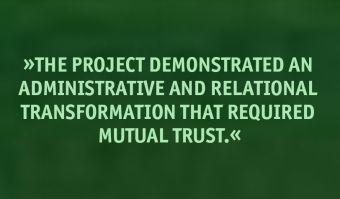
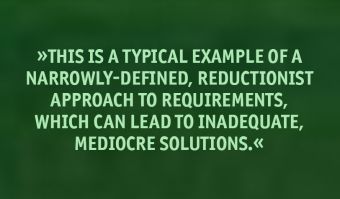
Urban planning: Transforming the notion of “smart cities” development
The original brief included a number of practical and functional requirements, and stated amongst other things that the bus station should: (a) be highly innovative, smart and sustainable; (b) promote a feeling of safety for passengers; and (c) involve citizens in its development. Most importantly, however, special emphasis was placed on the requirement to prevent heat loss from buses when opening their doors to (un)boarding passengers. This is a typical example of a narrowly-defined, reductionist approach to requirements, which can lead to inadequate, mediocre solutions. It was clear to the design researchers that a reframing of the project and requirements was necessary in order to approach the challenge as a ‚wicked problem‘ and come up with innovative interventions.
The first step in this reframing process was taken through a course at the Umeå Institute of Design. About 20 design students carried out design interventions in the city,
looking for meaningful experiences of public mobility. They involved passengers and bus drivers in designing and testing prototypes and mockups. At the same time, the team of designer-researchers found that an indoor bus station was not a viable option. The research showed that such a solution would not reduce carbon emissions, but rather it could lead to a potentially unsafe and difficult-to-maintain facility. The portfolio of design ideas from the students and the design research team pointed in another direction for reducing carbon emissions, namely increasing the willingness of people to use public transport more, by offering a pleasant traveling experience for passengers. Accordingly, the brief and the expectations of the municipality were transformed throughout the design process.
Being citizens: Transforming the Experience of Public Transport
Opened in October 2019—shortly before the pandemic hit—the Station of Being saw an increase of about 40% of passengers in the months following its opening compared to the previous year. Furthermore, the increase doubled compared to other nearby stations. A small pilot field study showed that people generally have positive feelings about the new station, and that the design scored highly with women in particular, due to the sense of safety it evokes (Åström, 2020). The Station of Being is now included in the Umeå Gendered Landscape (n.d.), and is deemed to have positively transformed the waiting experience.
Discourse and Awareness: Transforming learning
The final transformation we highlight here has to do with lifelong learning. The design research team initiated a participatory process aimed at empowering the relevant stakeholders, especially the municipal staff. Their active involvement in the design process increased their confidence in working beyond the beaten track. It reassured them in their leadership capacities and in their ability to participate in transformative processes. A clear example concerns the municipality’s snow ploughing service. Umeå is a town in northern Sweden that experiences heavy snowfall during several months of the year. The service was initially sceptical about how the design team might consider their needs. However, during the process they were able to regularly test how the bus station could be easily cleared of snow using machines, rather than the existing manual methods at traditional bus stops. The process increased their motivation, commitment and enthusiasm.
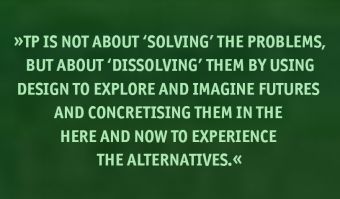
Design for Transforming Practices for a new European Renaissance
We are facing major societal challenges that call for multifaceted transformations, as illustrated by the example of Station of Being, including political, economical, social, technological, legal and environmental factors (also indicated as PESTLE) as well as demographic, ethical, ecological, intercultural, organisational and digitalisation factors (e.g. labeled as STEEPLED, DESTEP and SLEPIT) (Helmold & Samara, 2019). The escalation of tensions in our connected society—and the rebellion of the planet that has been exploited without any respect for its balance and the rights of all those inhabiting it—urgently demand new ways of working, fuelled by alternative value systems that are different from the status quo. These new ways of working together and inhabiting a planet in need of healing require transformations toward practices of mutual care, of repairing, experimenting, making and unmaking together. The Station of Being exemplifies some of these transformations.
The approach that we use in projects such as RUGGEDISED is known as Designing for Transforming Practices, in short TP (Hummels et al. 2019). It is an approach, or rather a quest to engage with the world in co-responsible ways, by transforming the status quo and developing new alternative practices (Hummels, 2021). TP catalyses liveable ecosystems by “transforming existing practices into truly sustainable ones, through design. It does it by initiating and curating multidimensional synergies, driven by beauty, diversity and meaning. The scope is to imagine and propose sustainable futures, which are those futures where all beings are respected and actions to heal the planet are taken, towards a horizon of collective thriving. Those futures are populated by people living purposeful lives, in beautiful living spaces” (Trotto et al. 2021).
This approach is founded on five principles: complexity, situatedness, aesthetics, co-response-ability and co-development. TP is not about ‘solving’ the problems, but about ‘dissolving’ them by using design to explore and imagine futures and concretising them in the here and now to experience the alternatives. TP stimulates critique, elicits dialogic debates that arise from tensions between the status quo and
alternatives, and finds new avenues for the flourishing of a new civilisation. Only from new practices can a new civilisation, and hence a new renaissance, arise (Trotto, 2011).
The process of the Station of Being underlines the ability and competence of designers to deal with ‘wicked’ problems, i.e. messy, complex problems which cannot be tamed or solved (Rittel & Webber, 1973). Designers have the attitude, skills as well as methods to deal with complexity and to tackle complex problems pragmatically. The quality of design and designers is that they can reframe and reconfigure challenges with the aim to dissolve them in the long run. With TP, we do not only aim at dissolving wicked problems, but we also focus on impacting future trajectories by changing attitudes and practices of involved parties, breaking boundaries between silos and addressing organisational aspects, as shown in the Station of Being.
Not only are they highly complex, but also our societal challenges carry a strong sense of urgency, asking for immediate actions. Hence we are bound to take actions

in the here and now while simultaneously generating a long-term outlook for both the future and history (100 years and more), thus connecting past, present and future. By working on several time scales at the same time, we prepare ourselves for serendipity, emerging outcomes and wicked impact. Above all, we do so by engaging with a broad spectrum of stakeholders to evoke co-response-ability.
With TP we want to contribute to a European Renaissance. In this new era, we are inspired and empowered to collaboratively explore processes and practices founded on care, trust and repairing. To be
able to contribute even better to a European Renaissance, we have recently made an exciting new step in our quest and established the Design Competence and Experience Centre, which “exists to catalyse ecosystems and transform existing practices into more sustainable ones, by initiating and curating multidimensional synergies, with beauty, diversity and meaning, for sustainable futures” (Trotto et al, 2021). It is an endeavour in which creativity can lead the ways (as opposed to “the way”) to unlock ourselves from old paradigms that lead to the depletion of the planet and of humankind. We invite you to join the quest for ushering in a European Renaissance.
REFERENCES
Åström, M. (2020). Innovations in Urban Planning: A study of an innovation project in Umeå municipality (Dissertation). Retrieved December 02, 2021, from http://urn.kb.se/resolve?urn=urn:nbn:se:umu:diva-171983Helmod, M. (2019). Tools in PM. In: M. Helmold and W. Samara (Eds). Progress in Performance Management: Industry Insights and Case Studies on Principles, Application Tools, and Practice, Springer. p 111-122. https://doi.org/10.1007/978-3-030-20534-8_8
Hummels, C. C. M., Trotto, A., Peeters, J. P. A., Levy, P., Alves Lino, J., & Klooster, S. (2019). Design research and innovation framework for transformative practices. In Strategy for change (pp. 52-76). Glasgow Caledonian University.
Hummels, C. (2021). Economy as a transforming practice: design theory and practice for redesigning our economies to support alternative futures. In: Kees Klomp and Shinta Oosterwaal (Eds). Thrive: fundamentals for a new economy. Amsterdam: Business Contact, 96-121.
Rittel, H. W., & Webber, M. M. (1973). Dilemmas in a general theory of planning. Policy sciences, 4(2), 155-169. https://doi.org/10.1007/BF01405730
Trotto, A., Hummels, C. C. M., Levy, P. D., Peeters, J. P. A., van der Veen, R., Yoo, D., Johansson, M., Johansson, M., Smith, M. L., & van der Zwan, S. (2021). Designing for Transforming Practices: Maps and Journeys. Internal publication. Technische Universiteit Eindhoven.
Umeå Gendered Landscape (n.d.). About the gendered landscape. Retrieved December 02, 2021, from https://genderedlandscape.umea.se/in-english/.
Ambra Trotto
Ambra is the Design and Research Director of the European Design Competence and Experience Center for inclusive innovation and socetial transformation and associate professor at the Umeå Institute of Design.She leads the Digital Ethics initiative at RISE, directing the strategic work regarding how RISE supports societal actors in taking ethics into account, when designing transformation with technology as a material. She is part of the RISE Development Team of the strategic research area Value-shaping System Design. She has initiated the environment of RISE in Umeå, leading The Pink Initiative, which is establishing, through design research, local, national and international multidisciplinary ecosystems, supporting business and society to thrive and create sustainable futures. Ambra has 16 years experience in writing and participating in various forms of European projects. Ambra Trotto’s fascinations lie in how to empower ethics, through design, using digital and non-digital technologies as materials. Strongly believing in the power of Design and Making, Ambra works with makers, builders, craftsmen, dancers and designers to shape societal transformation. Within her design research activity, she produces co-design methods to boost transdisciplinary design conversations. She closely collaborates with the Research group of Systemic Change and the Chair of Transforming Practices of the Department of Industrial Design at the Eindhoven University of Technology.
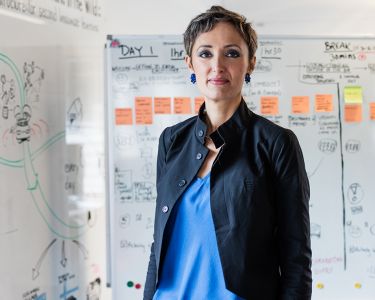
Jeroen Peeters
Jeroen is a Senior Design Researcher at the unit Societal Transformation, part of the department Prototyping Societies at RISE Research Institutes of Sweden. Within this capacity, he has contributed to a variety of national and international research and design projects with public and private sector actors. Since 2021, he is also a visiting researcher at the Systemic Change Group at the Department of Industrial Design at Eindhoven University of Technology. Jeroen´s research work focuses on how to design for engagement and the use of design methodologies to develop insights and knowledge of complex societal challenges. This work is centered around the design of proposals that make societal transformation experienceable with the aim of allowing stakeholders to feel and thereby understand what is necessary for a transformation to take place. Jeroen holds degrees in Industrial Design from Eindhoven University of Technology in the Netherlands (2012) and a PhD in Design Research from the department of Informatics at Umeå University in Sweden (2017).
Picture © Murat Erdemsel
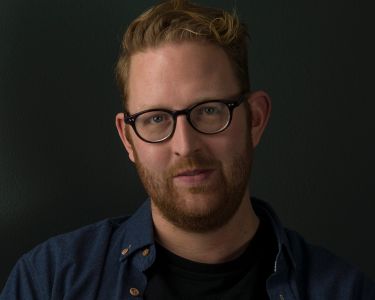
Caroline Hummels
Caroline Hummels is professor Design and Theory for Transformative Qualities at the department of Industrial Design at the Eindhoven University of Technology (TU/e). Her activities concentrate on designing for and researching transforming practices. She is linking nowadays challenges and complexities of quintuple helix partners, with probably, plausible, possible and preferable futures in the upcoming 5 – 100 years, through designing alternative ways to engage in complex socio-technical systems. She is thereby interweaving theory and practice, by developing with her team a design-philosophy correspondence, in which both disciplines mutually inform each other to address societal challenges.Caroline has always worked at the forefront of design research to develop the discipline, push its boundaries and address societal challenges. She is co-founder and steering committee member of the Tangible Embedded, and Embodied Interaction (TEI) Conference. She has been at the forefront building the Research through Design (RtD) field and community in the Netherlands. She is ambassador for co-creation and participation of the Key Enabling Methodologies (KEMs) for mission-driven innovation, advisory board member of the Dutch Design Foundation, associate editor of the Journal of Human technology Relations, and editorial board member of the International Journal of Design. Picture © Marike van Pagée
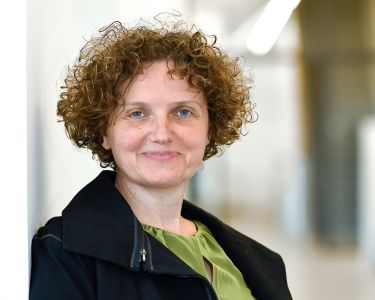
Pierre Lévy
Pierre Lévy is professor at the National Conservatory of Arts and Crafts (CNAM) in France, holder of the Chair of Design Jean Prouvé, and researcher at the Dicen-IDF lab. He is interested in the correspondence between reflection and design practices, pointing towards transforming practices and sciences. His research mainly focuses on embodiment theories and Japanese philosophy and culture in relation to designing for the everyday. Previous to his position at CNAM, he has been researcher at the University of Tsukuba and Chiba University in Japan, and assistant professor at Eindhoven University of Technology. He holds a Mechanical Engineering master’s degree (UT Compiègne, France), a doctoral degree in Kansei (affective) Science (University of Tsukuba, Japan), and a HDR in Information and Communication Sciences (UT Compiègne, France). He is also co-founder and former president of the European Kansei Group (EKG) and coordinator of the Kansei Engineering and Emotion Research (KEER) Steering Committee.
Picture © Nami Lévy
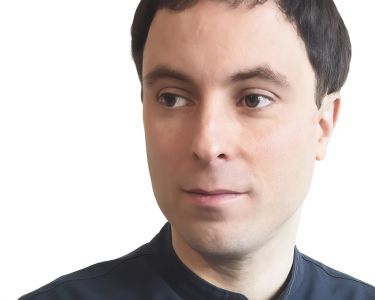
Daisy Yoo
Daisy Yoo, PhD, is an assistant professor at the Department of Industrial Design at the Eindhoven University of Technology in The Netherlands. Her primary research focus is on designing for public services and social sustainability. In her prior work she investigated issues of participation, inclusion/exclusion in politically contested design spaces – spanning from local issues concerning the co-design of public transportation service to global issues concerning the transitional justice for Rwanda in the aftermath of the 1994 genocide. Such work, entangled in the web of complex social dynamics, raises methodological and ethical challenges, calling for new design methods, toolkits, and theories. Prior to TU/e, she held the postdoctoral fellowship on participatory design at the Aarhus University in Denmark. She holds a PhD in Information Science and Human-Computer Interaction from the University of Washington, where she was advised by Batya Friedman of the Value Sensitive Design Lab. She received her Master’s in Interaction Design from Carnegie Mellon University, and her Bachelor of Science in Industrial Design from Korea Advanced Institute of Science and Technology (KAIST).
Picture © Vincent van den Hoogen
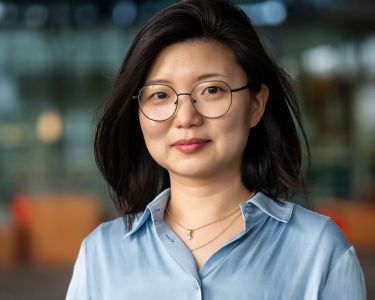
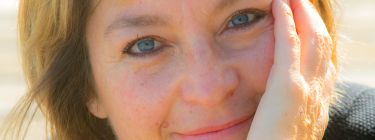
physical-virtual-virtual-virtual-physical-physical-virtual-physical-physical-virtual-physical-virtual-virtual-physical-virtual-virtual
Alejandra Panighi, Strategic Consutant at Mediapro, Madrid
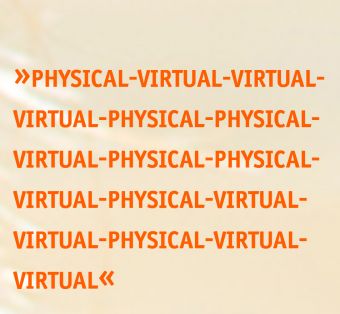
physical-virtual-virtual-virtual-physical-physical-virtual-physical-physical-virtual-physical-virtual-virtual-physical-virtual-virtual
In which metaverse do we want to live?
The Metaverse—A ubiquitous, synchronised universe where presence and sense of presence become indistinguishable.
For those of us who were born in the 20th century, the word „metaverse“ came to be associated with science fiction books and films of the 1990s which depict a dystopian future dominated by technology. In most of them, humanity is dominated by mega corporations, totalitarian governments or dehumanised scientists who use simulated worlds and robotic environments to subject people to situations of oppression, domination and injustice.
But for those who grew up with the online world as an integrated space within the physical world, the metaverse is simply a collection of all the virtual universes that coexist in the cloud and are necessarily shared, interactive, immersive and collaborative.
The metaverse is, for this generation, understood as an environment where the digital assets become an extension of the physical assets—precisely a moment when the blurring of this distinction simply happens.
It began perhaps with the mobile internet, and just accelerated with advances in the use of AR (Augmented Reality), VR (Virtual Reality) and AI (artificial intelligence) until becoming an increasingly present and ubiquitous mixed reality.
Creative industries, particularly video games, went deep into this concept of real-digital and digital-real, making immersive experiences a language of a generation who learned to live and enjoy these environments in which the physical person and its own digital extension coexist and converge.
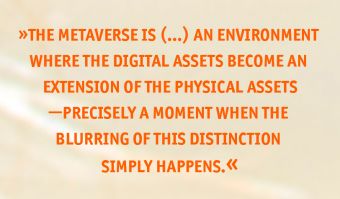
It is now the same generation that expects to integrate into this metaverse all the other aspects of their lives: sports, social activities, academic life, travel, work and global economy.
For several years, the narrative about this metaverse, as something real outside of films and books, was captive of those who worked to revolutionise the actual rules of Internet, developing the virtual economy from different but close perspectives. It was almost a cryptic universe, accessible to those who could quickly understand the token economy and its fungible and non-fungible tokens and the rules of permissions and permissionless environments—among many other concepts—in which „old“ inventions like Napster would have been unstoppable.
That is until 2021, when Facebook divested itself of its original brand and became Meta by announcing multi-million-dollar investments in augmented and virtual reality, robotics, high-tech VR glasses and sophisticated software applications to make the old Facebook social media network an environment for communication, fun and work in the metaverse.
Other giants of the internet 2.0 era such as Google, Microsoft or Apple also unveiled their plans to develop virtual environments with huge investments. This sudden trust in the virtual economy became a fillip for hundreds of start-ups who could suddenly access a flood of money in projects that few months ago previously have been considered extremely risky. How quickly and how much further it might go is yet to be seen, but lots of ethical questions are raised when we think about a near future where both worlds, the Physical and the Virtual, get together and shape our lives in a constant physical-virtual-virtual-virtual-physical-physical-virtual-physical-physical-virtual-physical-virtual-virtual-physical-virtual-virtual dialectic.
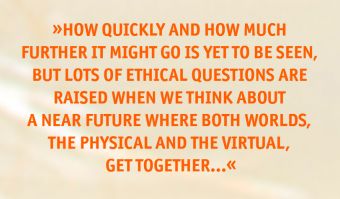
There are at least two main visions of how this Metaverse should be…
One is inherited from the current model of society, led by closed platforms and Big Tech that are not necessarily the bad boys of so many dystopian novels. But there are indeed few and dominant players of the digital economy of the 21st century. They claim the central role such huge machines should be allowed to have, to make this Metaverse happen in an ordered and controlled way, far from actual wilderness of the internet sphere that includes the worst we can see from ourselves in the deep and dark web.
Another vision, in stark contrast, talks about an Open Metaverse created with open technology and open protocols that allow increasingly decentralised and accessible environments for almost anyone. This is the vision of those creators of—and believers in—Web 3.0, which has been evolving for at least 10 years. They advocate for an Open Metaverse based on principles of digital sovereignty and easy access to data and protocols for people to achieve a new world economic order, an order perhaps better, perhaps fairer, perhaps more promising for those who now lie at the bottom of the actual world’s economy.
A third vision, probably the most plausible one, is a coexistence of both centralised and decentralised visions, convergent and divergent environments in which any kind of ordering or regulation will be complex but might prove necessary.
In any case, during the next few years we will experience a true ethical, moral, ideological and economic revolution that is somehow reminiscent of the profound change in society that took place during the Renaissance.
In these times, we will see the scaling of this virtual-based economy, environmental challenges, not only those arising from the digital economy but also those inherited from the current economy, new jobs and the transition between the old jobs and the new ones, and so many other challenges and so many inconsistencies in the meantime.
We’ll need to go through a deep revision of the grounds of Internet, the deepest since it was born:
– the whole process of capture and control of data
– the cost of electricity or other renewable power sources
– accessibility to digital resources
– the conversion from actual sleeping goods in Cloud wallets to the commercial retail system
– the backend of the internet (hardware and software)
– the actual network and nation-based technical infrastructure
– operating systems.
… And so many other concepts raising from the revision of these basic ones.
But also, rethinking what identity means, what belonging means. What is a community? What is fandom? Or random? The possibility of
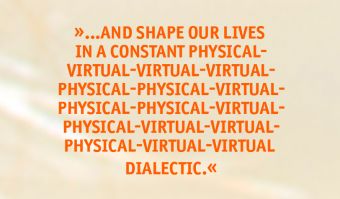
multiple identities for each person—physical and digital—and a possible total sovereignty for each opens up an unexplored universe.
The sovereignty of identity in the physical world, in the virtual world and in what emerges from the combination of both universes for future generations may completely change social relations in the decades to come.
Somehow, once again, as in Europe’s First Renaissance, the New Renaissance will be all about the convergence of Culture, Economy and Technology.
Alejandra Panighi
Born in Argentina, she started her career in TV in America as producer and journalist, but she was always attracted by all ways of storytelling in almost any written or visual formats too.So it was not a surprise when, in early 90’s, she joined the team that launched Yahoo and AOL portals in the American continent, when they were still a web directory of content curated by people. She experimented with live shows and live interviews with musicians, interacting also with those the few users who could access dial up connections for several minutes. Living in Europe for the last 20 years, she’s been focused in innovation of the film, series, live sport and eSports industries, looking for different business models and new ways of reaching audiences. She embraces technology as a driver for innovation and follows consumer’s behaviour with passion. From VR-XR to immersive experiences, from data management to AI and moving now in the arena of virtual economy her wide expertise on the evolution of the Audiovisual industry is an asset. Focused in EU policy for the last decade, she lives in Brussels and works as a strategic consultant for Mediapro Group, dealing directly with the Board of Directors.
Picture © Pepe Encinas (Barcelona, Spain)
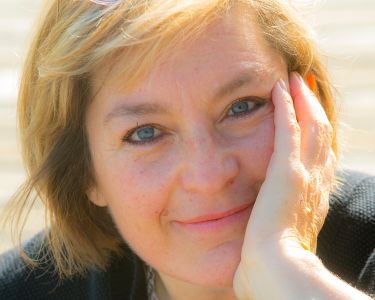
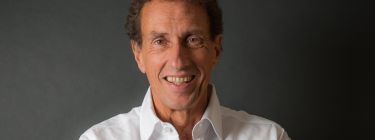
Digital transformation as a second renaissance?
Prof. Dr. Dr. h. c. Julian Nida-Rümelin, Staatsminister a.D., Director of Bavarian Institute for Digital Transformation and Vice-Chair of German Ethics Council, Munich
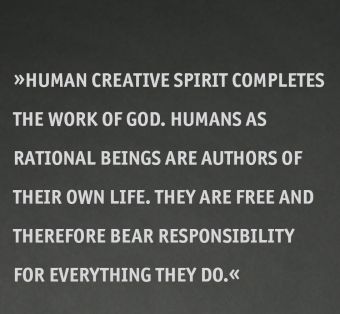
Digital transformation as a second renaissance?
Towards digital humanism
The European Renaissance began first in Italy after a period of exhaustion by plagues, misery and wars. In the mid-14th century, the plague had plunged Europe into one of the worst catastrophes of mankind, an incurable disease that brought great pain to those afflicted and usually a quick death. Even before the plague, a long-lasting famine had taken hold, for which climate change in the form of significantly falling temperatures probably played a decisive role. The structures of social order eroded and everyday life became brutalised. The population declined markedly, with the paradoxical effect of a valorisation of human labour and an increase in productivity brought about by new technologies. The European Renaissance was preceded by a creeping decline in the authority of clerical and princely authorities, and was characterised by a return to ancient thought, especially that of the Greek Classical period and the Roman Empire. Aristotle was disposed of—prematurely—because the Thomasian worldview, unlike patristics, was based on his writings and had made them the authoritative source alongside the Holy Scriptures.
The young intellectual Pico della Mirandola (1463-1494), born into high wealth and highly gifted, published his writing De hominis dignitate (Rede über die Würde des Menschen EA: 1496) and ensured that it was discussed throughout Europe by intellectuals and eventually also by ecclesiastical authorities. At the centre was an image of God that endows man with artistic creativity, technical innovation, and scientific research; indeed, one might say that in this writing Pico della Mirandola anticipated the thesis of the analytical philosopher Roderick Chisholm that man, like God, is an unmoved mover (Die menschliche Freiheit und das Selbst (1964), S. 82). Human creative spirit completes the work of God. Humans as rational beings are authors of their own life. They are free and therefore bear responsibility for everything they do. Only Immanuel Kant thought the consequences to the end in his practical philosophy of autonomy.
The Renaissance was an epoch of impressive innovation. And like other innovative periods in human history, it was characterized by the breaking up of schools and conventions, by interdisciplinarity, and by the fluid transition of philosophy, science, technology, and art. Education was no longer the learning of preconceived patterns of thought and practice, but self-education with the goal of life-authorship. Leonardo da Vinci did not know whether to see himself as a scientist, technician or artist. The Renaissance cities became documents of impressive design in the combination of technology, craftsmanship, art and science.Are we on the threshold of an era of comparably far-reaching innovations, shaped by the potential of digital technology? To be able to assess this, we first have to face a sobering fact. The third wave of digitisation has not yet made a significant contribution to either labour-hour or resource
productivity. The platformisation of the economy has reshaped it to some extent and created large tech giants, but it has not stimulated growth, or at least not noticeably. In a ranking by the World Economy Forum a few years ago, Germany landed in first place among the most innovative countries in the world—probably to the surprise of the authors—while at the same time being one of the most digitally backward. Working hour productivity in Germany is almost a third higher than the EU average while almost all European countries are outstripping Germany in terms of digital transformation. The productivity of the German economy is just behind Norway and Switzerland, but well ahead of France, Canada, the U.S. and Japan (which leads the East Asian countries). The productivity boost that digitisation triggered with the introduction of personal computers and the use of the Internet in the 1990s has not been repeated in the third wave. At the same time, however, the world is in dire need of a technologically-driven increase in productivity in the face of resource scarcity, ecological depletion and climate change.
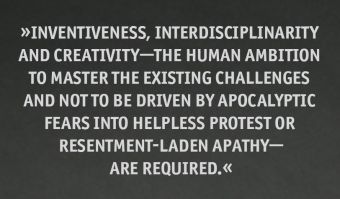
All the inadequate efforts to cut CO2 since the 1990s have been far outweighed in Europe by the additional CO2 emissions of the Chinese economy. Meanwhile, the Chinese economy is polluting the atmosphere with climate gases at a higher rate than the US and Europe combined—even though China’s economic output ranks only third after the US and after the EU. If other current and future boom regions such as India or sub-Saharan Africa follow the development path of China, the climate catastrophe in large parts of the world cannot be stopped. The digital transformation must enable other development paths and use human and natural resources far more sparingly without stifling economic momentum in a development phase where the demographic dividend pays off in the global South.
Inventiveness, interdisciplinarity and creativity—the human ambition to master the existing challenges and not to be driven by apocalyptic fears into helpless protest or resentment-laden apathy—are required. A rapid changeover to climate-neutral and ecologically sustainable economic activity, first and foremost in the highly industrialised countries, the treading of new technological, economic and social development paths in fair cooperation between the world’s regions and the mobilisation of human resources in order to overcome the major challenges facing humanity will only be possible with the massive use of digital technologies.
Not data thriftiness, but protection of personal rights and use of data for humane progress in medicine, natural science and education, in state administrations, small and medium-sized enterprises, the efficient and effective organisation of social cohesion, are indispensable for this. The humanistic ideal of human authorship, self-education and creative power must experience a renaissance under digital auspices.
Responsibility remains solely with human actors. Software systems, highly developed so-called „autonomous“ ones as well as those which are called „artificial intelligence“ (AI), are not actors, not people. Man does not become God, who creates other individuals in his image to use them at will for himself. They are merely technical, albeit highly sophisticated, tools that we should use individually and collectively, legally framed and politically shaped, for the good of humanity. This is the central message of Digital Humanism: machines are not people and people are not machines. The currently fashionable AI animism is unscientific mumbo jumbo, a projection of a familiar type that animates the unsouled and gives satisfaction to the swashbucklers. And man is not a machine, not an algorithm-controlled software system, but a freely responsible actor of his actions. Digital technologies will not relieve him of this responsibility, but neither will they take away his freedom to individually and collectively shape life and its conditions.
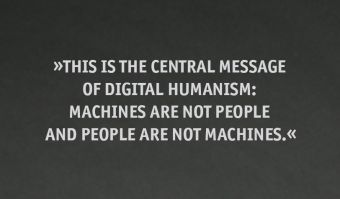
The renaissance of digital transformation is based on the empowerment of human authorship, on the development of human creativity, on the targeted, intelligent and measured use of new technologies for human purposes. It aims to humanise the world of work through sustainable production and the establishment of fair practices in the global economy, while the current development path has established monopoly structures in the form of large tech giants, shifted greater parts of economic value creation to platforms and made a successful business model out of the skimming of user data from digital service offerings for marketing purposes. This humanistic form of digital transformation will not be feasible without a state framework in the form of digital infrastructures, without an independent European path of „human centred AI“ and transparent uses while safeguarding informational self-determination rights, without a European legal framework of digital dynamics. But the chances are good that the humanistic form will ultimately prevail over the commercial model of Silicon Valley and the state control model of China and other autocratic and totalitarian states.
Prof. Dr. Dr. h. c. Julian Nida-Rümelin, Staatsminister a. D.
Julian Nida-Rümelin teaches philosophy and political theory at Ludwig Maximilian University in Munich.JNR was a member of the first Schröder cabinet as Minister of State for Culture and Media. He is a member of the Academy of Sciences in Berlin and the European Academy of Sciences, director at the Bavarian Institute for Digital Transformation (bidt). In 2016, the Bavarian state government awarded him the medal for special services to Bavaria in a United Europe. In 2019, he received the Bavarian Order of Merit. Since May 2020, he has been a member (as deputy chairman) of the German Ethics Council. In 2016, Humanistische Reflexionen (Humanistic Reflexions) was published by Suhrkamp. In the fall of 2018, he published a monograph on Digitaler Humanismus: Eine Ethik für das Zeitalter der künstlichen Intelligenz (Digital Humanism: An Ethics for the Age of Artificial Intelligence) (Piper Verlag), for which he received the Bruno Kreisky Prize in Austria for the best political book of the year. In spring 2020, edition Körber published Die gefährdete Rationalität der Demokratie (The Endangered Rationality of Democracy) and DeGruyter Eine Theorie praktischer Vernunft (A Theory of Practical Reason). Picture © Diane von Schoen

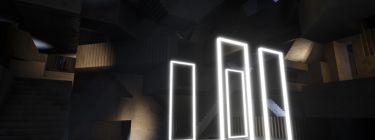
New Stages for Collective Imagination
Annette Mees, Artistic Director of Audience Labs, King’s College London and Creative Fellow at WIRED, London
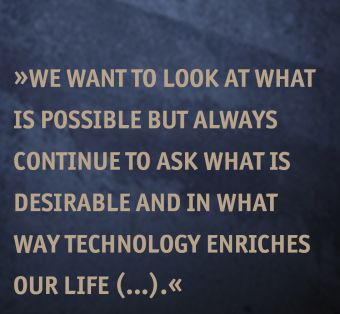
New Stages for Collective Imagination
The show must go on
Cultural institutions the world over collectively seek out new ways to connect meaningfully to local, global and diverse audiences—To co-produce and programme new kinds of experiences created with new kinds of creative teams and new kinds of partners offers exciting opportunities. Audiences are eager to connect with both big ideas and one another and have challenging and new experiences ahead. Audience Labs is an artist-led initiative looking at the intersection of Performance, Innovation and Social Change and was born at the Royal Opera House in London’s Covent Garden, a location with a centuries-old tradition of performance. Introducing the creative practices of opera and ballet to immersive technologies provided a unique opportunity to look at bringing human emotion and collective experiences together. We want to look at what is possible but always continue to ask what is desirable and in what way technology enriches our life in the wider societal shifts and upheavals of the digital and green transformations taking place before our eyes.
I’m a theatremaker not a technologist. I work in the arts because it has a public function—it’s a space to collectively reflect and imagine, a space that can help us explore what it means to be human in a future society and what it can contribute towards a next Renaissance. I’m interested in the artistic potential of technology and the role art and culture can play in shaping our relationship to the world, to each other and to the technologies we use in that process.
Picture above: Current, Rising CGI Production Shot House of Subconscious, Copyright: Joanna Scotcher & Figment Productions
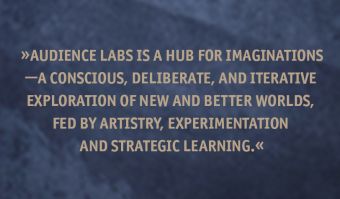
Current, Rising: an opera in hyper-reality
One of the projects Audience Labs presented in 2021 was Current, Rising. Described as the world’s first ‘hyperreal’ opera experience, it invites audiences to step into an atmospheric virtual world and take centre stage in the performance.
When I joined the Royal Opera House I was inspired by the ‘epicness’ of opera, the way the storytelling was driven by music first, narrative is secondary, the events are there to support the ideas and emotions. So many of them are about heightened emotions, to let you feel all the feels, so to speak, everything is bold and big. In opera the word Gesamtkunstwerk is used, or „all-embracing art form“.
Hyperreality combines Virtual Reality with a physical set and visceral effects like wind, heat, touch and movement to create a multi-sensory, immersive experience. It uses tracking to create a shared experience—the audience can see each other in the virtual space. It felt like an inherently operatic medium, which could enable audiences to step into an imaginative universe and to be the lead characters in it.
We wanted to do a project like this because it allowed us to use the possibilities of hyperreality to expand the idea of what an opera can be, both in the process of creation and in the audience experience. We set out to challenge the traditional hierarchies of opera and searched for different approaches to creating a 21st-century version of a Gesamtkunstwerk: A challenge and change of hierarchy to be found in many sectors, markets and communities now on their way to invent new sustainable and green ways of living and working. For us Current, Rising puts the opera as an institution right in the middle of these transformational debates about possible futures in Europe.
Fellow Travellers
Our starting point for projects is always identifying the most interesting questions—often that is a ‘What If’ question. The immediate second step is casting the right people to explore those questions with. Exploration and innovation is not something one does on one’s own. We believe that the power of creativity and innovation grows exponentially with the diversity and multiplicity present within a team. It is most powerful when based on a shared vision, shared vocabulary. When we visited Figment Productions, their technology and creative team felt like a perfect match. They had a radically different background from us, making work for theme parks and big live events, but they shared our enthusiasm for radical new ways of working, deepening the audience experience and doing everything with imagination. They, like us, were curious about the potential of a hyperreal opera and equally important brought a real sense of technological poetry to the table.
We brought together a highly-experienced and diverse creative opera team. We facilitated a series of sessions where we explored opera and hyperreality, finding directions of travel that might unlock something exciting. I call this establishing the artistic nucleus. Since we were not only inventing what a hyperreal opera might but also how we make it, we needed a space to develop a vocabulary before going into production. We gave makers time to develop attitudes and taste before landing on what they wanted to say on that particular stage; we enabled technologists to find artists that inspired and pushed them in new directions. It was the equivalent of making rough sketches before you decide what the painting looks like.
Picture right:
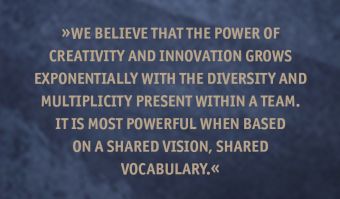
Iterate
Audience Labs embraced iterative working as a way to try out new ideas, and to de-risk investment and learning. When trying to create something both artistically valuable and highly innovative, you need time to fail and learn, reassess, make changes and try a different approach. Many projects start with an inkling of the possible but need time to gather the right ideas and the right team to work towards something that has meaning and value to an audience. Although an overemphasis on efficiency stifles innovation, iteration is simultaneously the most efficient way to look after your money. Innovation is inherently risky and unpredictable. But by working in stages, starting small and slowly scaling up to full production, you de-risk investment that is necessary for large-scale productions.
Current, Rising used techniques from theatre, technology and design to create a process that allowed the artistic and technological developments to iterate together towards a meaningful piece of work.
We started on paper, trying ideas and concepts out by making simple sketches, storyboards and mock ups. Some of the places we borrowed from included:Theatrical rehearsal and devising techniques
– Game design
– VR production pipeline
– Double diamond model
– Experience design
We shared work often and openly between the team until we knew we had the right story, technology, aesthetic and approach for the project to soar. Only then did we go into the full expensive production period. This approach allowed us to adapt to the complexities as the project grew and deliver an extraordinary project on a tight budget.
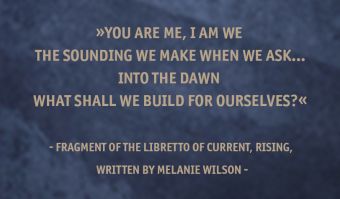
The show
The show that emerged from this process was Current, Rising. Inspired by the liberation of Ariel at the end of Shakespeare’s Tempest, Current, Rising takes four people at a time on a journey through the six phases of the night. Participants are empowered to collectively explore a series of imaginary dreamscapes, travelling from twilight to dawn as they encounter ideas of isolation, connection and re-imagination. It explores freedom as a process within our control, rather than as a state in which we exist, and asks how we might harness personal responsibility to join with others to re-think the future.
The audience enter a real life theatre set wearing VR headsets and go on a dreamlike journey carried musically by a poem layered in song. It takes the epic, music-driven and poetic qualities of opera and combines it with the possibility of VR to create any possible landscape, defying all natural laws, pushing beyond what is possible on the stage. In Current, Rising music, the visual world and the physical experience are completely enmeshed, changing the relationships between the creators, the usual sequence of creation, and the relationship of the audience to the work. Here the audience members are the protagonists: they are inside the work, and their physical experience is a part of the work itself.
The audience and the response
An audience research conducted by Royal Holloway discovered fascinating results.It brought new audiences to opera: 31% had not been to the Royal Opera House before and 68% of these new audiences were under 35.It also brought new audiences to the technology: 32% had not experienced virtual reality before. A lot of those were regular opera goers.
Many reported on a potent emotional experience, with uniformly high enjoyment ratings (an average of 4.6 out of 5) with an equally high rating in the seasoned opera goers and VR users and first timers. That cross-pollination of different audiences is really exciting—people who wouldn’t meet each other under different circumstances shared an experience in this show.
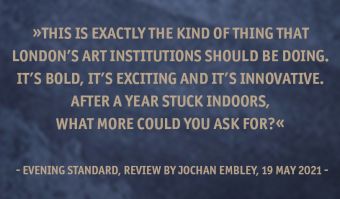
An audience research conducted by Royal Holloway discovered fascinating results.It brought new audiences to opera: 31% had not been to the Royal Opera House before and 68% of these new audiences were under 35.It also brought new audiences to the technology: 32% had not experienced virtual reality before. A lot of those were regular opera goers.
Many reported on a potent emotional experience, with uniformly high enjoyment ratings (an average of 4.6 out of 5) with an equally high rating in the seasoned opera goers and VR users and first timers. That cross-pollination of different audiences is really exciting—people who wouldn’t meet each other under different circumstances shared an experience in this show.
Possible futures through art
Current, Rising is one of many projects we developed at the Royal Opera House. In our three-and-a-half years there we worked with 22 partners and 44 artists spread over 14 countries. We explored a range of technologies including game engines, motion capture, animation, augmented reality and virtual reality and worked with artists working in opera and ballet, visual art, music, design, digital art, make-up and filmmaking. This convergence of perspectives, practises and ideas provided an incredibly fertile ground on which to create new ways of thinking about art and new possibilities for creative expression.
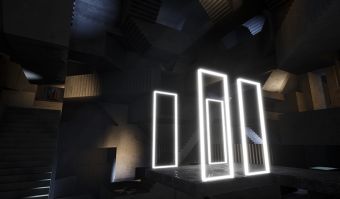
Art can make a world worth living in. After shelter, equality, equity and a healthy planet, there is art. Audience Labs explores possible futures through art—we aim to construct shared experiences and transformative moments that enrich people’s lives.At a time when we’re all struggling with what the future holds, we wanted to bring makers and audiences together to imagine a shared future, reflecting collectively on: Where shall we go? How do we want to feel? What do we want the world to look like? We are interested in expanding where culture takes place, and broadening who it is for, who gets to make it and how it interacts with other agents of connection and change in the world in the Next Renaissance
As Audience Labs is starting its time at King’s College London, we will be working with a network of industry experts, collaborators and experts to focus on critical questions surrounding the future of performance.
Picture left: Current, Rising CGI Production Shot House of Subconscious, Copyright: Joanna Scotcher & Figment Productions
The work will focus on four strands:
1. Artistic Futures—how do we make good and meaningful art that both explores new opportunities for connection and rising to the challenges of an uncertain world? This includes inclusive international collaboration, remote creative processes, audience and community engagement, and new partnerships.
2. Cultural Metaverses—exploration of technical infrastructures needed to create and deliver a distributed cultural experience, including distribution models, and digital dissemination, expansive audience engagement and business models.
3. Ethics, Audiences, Diversity and Inclusion. As we move towards new possible futures for art and culture in a hybrid age, we need to support work that promotes a more equitable ethical world for all.
4. Towards a Net Zero Profile. We will explore the use of digital and physical green innovations that promote reduced travel and touring, and will support the development of low/no impact stages, and the green venues of the future.
Initially, in this new context at King’s, we will take the opportunity to convene a wider ecosystem of artists and cultural organisations, technology partners, researchers and students to explore these questions and lay out possible methodologies and projects to start that journey. A practical plan on how we work together to innovate and make great art with ethics, equity and inclusion at the heart.
We don’t have all the answers yet. I see the role of Audience Labs as a place that combines conversations with practical artistic production—an intersection that a Next Renaissance cannot do without. Audience Labs might well be understood as a Renaissance sandbox in exploring and R&D-ing how culture can help understand the ethical side of technology, how culture can push the envelope.
Innovation is constant iteration, a form of continuous thinking, trying and pushing. Artists and arts institutions need partners that share their civic values to enable innovation. Only in value-based and wide-ranging partnerships can the arts create value, change and equity for audiences and communities everywhere: a societal Gesamtkunstwerk or in other words, social cohesion in the transformations ahead of us.
Picture right: Current Rising – set design by Jo Scotcher, Copyright: Johan Persson
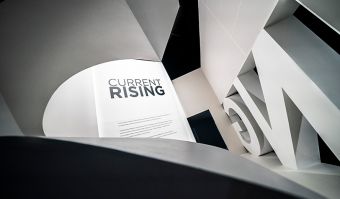
Annette Mees
Annette Mees is an award-winning immersive theatre director known for her innovative, interdisciplinary, experiential work that allows audiences to explore big ideas and meaningful change. She is the Artistic Director of Audience Labs; a hub for imagination exploring new forms of theatre and technology to dream up sustainable, diverse and equitable futures. It connects artists, technologists, researchers, experts, communities to spark new thinking. We use centuries of stage craft and the possibilities of cutting-edge technologies to create spaces for radical imagination, emotional connections and collective experiences. Audience Labs started at the Royal Opera House and recently moved to King’s College London to explore the underlying questions emerging around these new forms. We want encourage work by interdisciplinary, diverse and inclusive partnerships that is driven by imagination and equity, works towards net-zero and uses technological possibilities ethically. Next to that she works as an innovation strategist, artistic advisor and dramaturg for a range of organisations and projects. Currently she is the chair of FutureEverything, a co-host of global conversation around the future of culture supported by Arup and Therme, an artist mentor for CPH:DOX and developing a strategic R&D project with Substrakt.
Picture © Annette Mees
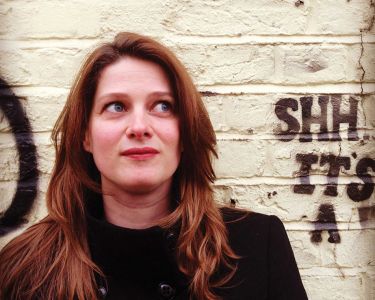
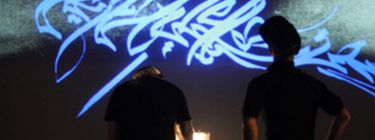
Connecting people and places
Susa Pop, co-founding director of Public Art Lab and Connecting Cities Network; Martijn de Waal, professor at the research group Civic Interaction Design at Amsterdam University of Applied Sciences, Berlin
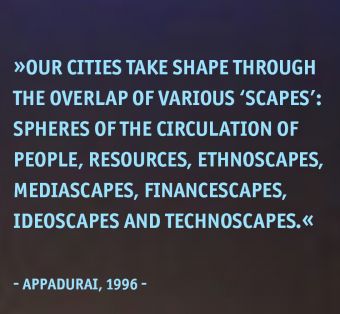
Connecting people and places
Why Cultural Led Urban Developments are necessary for Resilient Cities
Placemaking is a global civic trend in urbanism. However, a novel combination of arts, technology development and processes of urban governance empowers placemaking to be responsive and forms an essential contribution to a next renaissance of global cities. Not necessarily by making them less global as the following case studies show, but by bringing in a perspective of interconnected local publics and public values to urban policy, from the design of public spaces to the organisation of urban resource management and carbon-neutral cities.
Picture above: Digital Calligraffiti 2017-21 commissioned by Public Art Lab in cooperation with the artists Michael Ang, Don Karl and Hamza Abu Ayyash, Copyright by Michael Ang and Public Art Lab
Responsive Placemaking
Our cities take shape through the overlap of various ‘scapes’: spheres of the circulation of people, resources, ethnoscapes, mediascapes, financescapes, ideoscapes and technoscapes.1 The rise of new technologies and their accompanying practices in the past quarter of a century—from budget airlines to the internet—has intensified the flows in these various scapes and between them. Today we witness interlinked geographies of these scapes across the globe, making the world’s cities ever more interconnected. Hence, from the mid-1990s onwards, scientists, policy makers and mayors around the world increasingly started to think of our cities as part of networks of global cities, immersed in a space of flows, facilitating a worldwide creative class. However, as has become clear, these global cities did not only produce economic growth and innovations—from tech to finance—but also huge inequalities, both between and within cities, both economically and in terms of cultural and political equity.
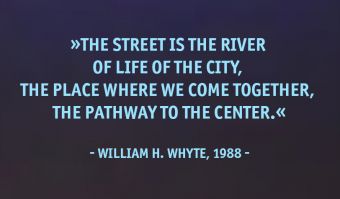
To address the tensions and inequalities that have arisen from the emergence of global cities, new approaches are needed that combine top-down urban policy with bottom-up ‘citymaking’ and centre around public values. Such an approach should not so much deny the interconnectedness of cities, the rise of digital networks, or the dynamic interaction between the various scapes. Rather, these should be embraced from a different perspective: a perspective that foregrounds civic relations and public values. In the past decade or so, digital and responsive placemaking has emerged as an approach that does exactly that. Digital and responsive placemakers understand our cities as ‘hybrid spaces’, simultaneously produced by their physical design as well as through their manifestations in virtual networks. The experience of a city is not just that of its buildings and monuments, its materialised institutions like city halls and local libraries and locally embedded cultural practices from weekly markets to critical mass bike rides. Increasingly, the ways in which the city is made up also include mediated versions of these experiences, through urban sensor data, social network practices and the search algorithms of digital map services, all reinforcing each other.
Responsive placemaking integrates this perspective with former ideas about placemaking that go back to Jane Jacobs and William W. Whyte and their groundbreaking visions and methodologies in the field of urban planning and architecture of the 1960s and 1970s. Revolutionary for their time, they brought out the importance of the seemingly trivial practices and rituals of everyday life for the success of cities, focussing on the street as a site in which social relations, trust and urban society could take shape. “The street is the river of life of the city, the place where we come together, the pathway to the center.”2
Responsive placemaking enhances such a perspective with new modes of representing and experiencing the city and the built environment and, more generally, time and space.
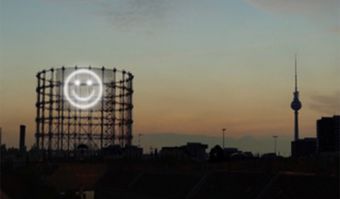
Picture above: Public Face I @Mood Gasometer, Berlin Schoeneberg, comissioned by Public Art Lab for the Media Facades Festival, Copyright by Julius von Bismarck and Public Art Lab
New Practices
Responsive placemaking can take various forms, and we’d like to highlight three of these here as examples of projects in which we have been involved ourselves.First, through projects of representation, responsive placemaking highlights the connections between people and places, and contributes to the construction of local publics. They can aid bringing out a ‘sense of place’ as well as a layered, variegated ‘sense of us’.
Second, as collaborative management and governance, responsive placemaking aims at providing these local publics with tools to organise themselves as collectives, addressing civic engagement and social inclusion. It seeks to set up alliances and coalitions of citizens, government representatives and professionals to organise around issues of communal concern, and the collaborative and inclusive management of local resources, from reusable energy communities to commons-based housing cooperatives.
And third, illustrating practices of translocal exchange and mutual learning, responsive placemaking does not approach local initiatives as isolated communities, set in their own time and place. Through the various scapes they are often part of various translocal movements and communities that enable mutual learning.
New Relevance of Translocal Communities and Mutual Learning
As such, in times of global pandemic, responsive placemaking becomes relevant in the context of border closures, spatial isolation, loss of mobility within and between cities, social distancing and quarantine measures. Although the pandemic has had devastating effects for individuals and societies globally, it is also an opportunity to rethink the ways we engage in intercultural dialogue and responsive placemaking in sustainable and equitable formats. As stated by Michele Acuto, director of Connected Cities Lab and professor of global urban politics in the School of Design at the University of Melbourne, “empowerment and community-building need to be at the heart of the digital lessons we are learning from COVID-19.“3 Although we are not travelling, we must work to understand better new types of transnational mobility. According to Federico Parolotto, in post-pandemic landscapes, hyper-mobility may be less feasible and therefore “digital connectivity will emerge as the most prominent transport technologies.”4 Although we are social beings, and most of us crave physical connectedness with others, the pandemic has revealed that we can and must continue to develop effective, inclusive and meaningful ways to connect digitally—novel forms of mobility.
Public Face: How does Berlin feel today?
Public Face5 is a showcase of responsive placemaking contributing to the representation of publics. It transformed a gigantic screen at the Gasometer in Berlin Schoeneberg into a ‘Mood Gasometer’ representing the emotions of the citizens in Berlin. It was developed for the Media Facades Festival6 in 2010 as a realtime data visualisation. The artist team Julius von Bismarck, Benjamin Maus and Richard Wilhelmer recorded and filtered the faces of the citizens with the newly developed software of facial recognition and transmitted the data of the dominating emotions of the group in the form of a emoji in real time on the big screen of the Gasometer with the question, „How does Berlin feel today?” By gathering data in public space, and by scraping social networks, these installations display collective ambiences and moods, communal spatial use patterns, and shared concerns back into public space through media installations. At the same time, and more critically, Public Face also establishes a critical public around the issue of urban surveillance.
Circulate
The Amsterdam-based project Circulate contributes to the design of local management and governance tools for urban publics, and in particular for resource communities. Increasingly, in the Netherlands and other parts of the world, citizens have started to organise themselves around sets of shared resources.7 Their motivation to do so is that they want to find alternatives to the extractive and unsustainable modes of production and organisation of many economic models, from housing to energy. Instead, they are looking for ways to share resources in a pro-social way, based on the principles of the commons, and to contribute to the production of renewable energy or the circular economy. New technologies such as urban sensors and database technologies such as distributed ledgers and smart contracts promise new ways to administer and govern these communities. Yet, the design of such digital platforms posts various questions that need to be resolved: To what extent is it a good idea to trade off privacy against transparency? To what private, collective or public goals should the set-up of a system be algorithmically tuned? For responsive placemaking to succeed, experimental designs of urbanism have only just begun.
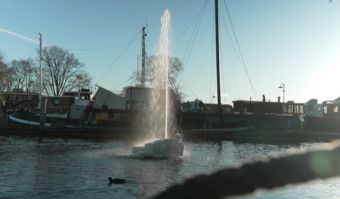
Picture above: Circulate. For the project Circulate. Designing Digital Platforms for Resource Communities, Design researcher Tara Karpinski made the Ener-geyser – a data fountain visualizing the energy use on a local grid in real time, as a conversation piece to discuss the values at stake in the algorithms that optimize energy exchange. Copyright by Tara Karpinsk and Public Art Lab
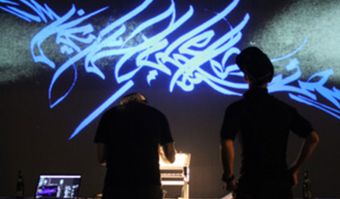
Picture above: Digital Calligraffiti 2017-21 commissioned by Public Art Lab in cooperation with the artists Michael Ang, Don Karl and Hamza Abu Ayyash, Copyright by Michael Ang and Public Art Lab
CONNECTING CITIES: Urban Screens mediate togetherness of distant publics
The European Lighthouse project CONNECTING CITIES8 explores translocal exchange through artistic practices, the networked infrastructure of urban screens, media facades and projection walls worldwide. Its goal is to engage citizens from distant places in new creative forms of togetherness and exchange. Under the guiding principle ‚Urban Screens are our Walls’, the CONNECTING CITIES NETWORK transforms these digital infrastructures into platforms and visualisation zones which provide new opportunities for communication, community building and translocal dialogue and telepresent scenarios in the public space by overlapping layers of virtual reality, augmented reality and networked society. For example, DIGITAL CALLIGRAFFITI9 allows all social groups to freely share their messages, wishes and visions on burning issues of our society. It combines the traditional cultural technique of calligraphy and graffiti with the possibilities of urban media art and new technologies. DIGITAL CALLIGRAFFITI transforms walls and digital screens into a canvas of civic expression to build bridges of intercultural understanding and promoting diversities as the medium to bring us closer.
A Vision for a Responsible Citizen-based Renaissance
The use of urban media technologies such as sensing and interaction technologies, social media, virtual and augmented reality tools and streaming solutions can strengthen community building and civic engagement in novel placemaking practices—such “responsive placemaking” promotes the democratisation of public space, facilitates public awareness about the urgencies of climate change with potential worldly resonance and enables the togetherness of people in dispersed and diverse locations. This multidimensional responsiveness of placemaking inserts citizen bottom up process in urban development of newly emerging resilient cities—such as the 100 Carbon-Neutral Cities in Europe til 2030—and will be part and parcel of Responsible Next Renaissance, responsive and responsible to its citizen-driven novel arts and technologies.
References
1 Appadurai, A. (1996). Modernity al large: cultural dimensions of globalization, volume 1. U of Minnesota Press.
2 William H. Whyte in City: Rediscovering the Center (1988)
3 Acuto, M. 2020, ‘Will COVID-19 Make Us Think of Cities Differently?’: https://newcities.org/the-big-picture-will-covid-19-make-us-think-cities-differently/
4 Federico Parolotto, F. 2020, ‘Mobility in the Age of Coronavirus’: https://newcities.org/the-big-picture-mobility-in-the-age-of-coronavirus/
5 Public Face is commissioned by Public Art for the Media Facades Festival 2010 http://connectingcities.net/project/mood-gasometer
6 Media Facades Festival 2010 is initiated by Mirjam Struppek and Susa Pop, Public Art Lab http://mediafacades.eu
8 The Connecting Cities Network is co-funded by the European Union / Culture Programme 2007-2013 and initiated by Public Art Lab http://connectingcities.net/
9 Digital Calligraffiti initiated by Public Art Lab in cooperation with Don Karl, Michael Ang and Hamza Abu Ayash
Susa Pop
Susa Pop is co-founding director of the platforms Public Art Lab and the Connecting Cities Network which contribute to creative citymaking, citizen science and translocal dialogue that empower social interactions and citizens‘ engagement. Susa Pop is an expert in investigating, curating, and producing artistic projects in the urban public sphere at the intersection of media arts, urban planning and digital naturalism. Best showcases include Mobile Studios, Media Facades Festivals, Urban Screens Innovation Forum, Connecting Cities, Future DiverCities, Digital Calligraffiti, Renewable Energy Avantgarde, Augmented Europe, Connecting Cinemas in Rural Areas. She holds lectures worldwide and gives seminars at the Bauhaus University Weimar / Media Architecture. She is co-editor of Urban Media Art Cultures (avedition, 2012) and What Urban Media Art Can Do – Why, When, Where, and How? (av edition, 2016). In 2017 she co-initiated the globally networked Urban Media Art Academy together with Tana Toft Ag in cooperation with the Goethe-Institut Thailand.
Picture © Ruthe Zuntz
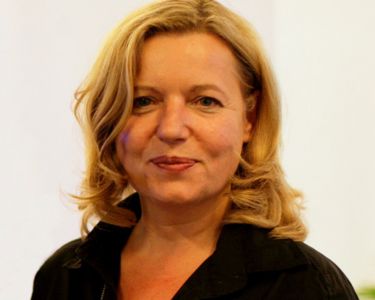
Martijn de Waal
Martijn de Waal is a professor at the research group Civic Interaction Design at the Amsterdam University of Applied Sciences. His work focuses on the experience of public spaces in a networked society and investigates the design of digital technologies from a perspective of public values. Recent research projects include The Hackable City on practices of collaborative citymaking; Circulate on the design of digital platforms for commons-based research communities and From Prevention to Resilience on the role of public space design in making neighborhoods more resilient in the aftermath of the Covid-crisis. He was the general chair for the Media Architecture Biennale 20. Key publications include The Platform Society. Public Values in a Connective World (Oxford University Press, with José van Dijck and Thomas Poell), The City as Interface. How New Media Are Changing the City (Nai010 Uitgevers) and The Hackable City. Digital Media and Collaborative City-Making in the Network Society (edited together with Michiel de Lange).
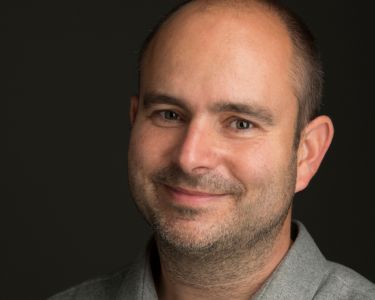
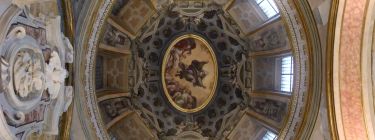
The New Relevance of Heritage
Professor of Sociology of Law since 1986, is Rector of the Suor Orsola Benincasa University of Naples, Vice President of the CNR (National Research Council)
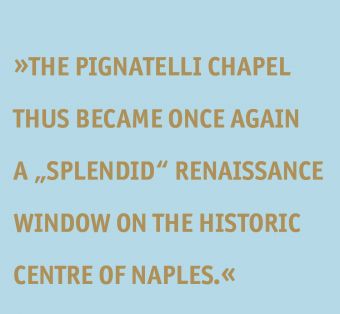
Renaissance 1.0
Case study: The Pignatelli Chapel, Naples: How bringing past Renaissance alive with digital tech opens new civic and economic spaces
The chapel or small family church of Santa Maria dei Pignatelli, located in the heart of Naples, in Piazzetta Nilo, has 14th-century origins and was first renovated from as early as the last decades of the 15th century at the behest of Ettore Pignatelli, Duke of Monteleone and Borrello and future viceroy of Sicily. The works lasted until 1515 and included the construction of the two important funerary complexes that make the chapel one of the jewels of Neapolitan art of the mature Renaissance: the tomb of Carlo Pignatelli, on the left wall, the work of Tommaso Malvito’s workshop around 1506-07; and the small chapel of Caterina Pignatelli, the work of the great Spanish sculptor Diego de Silóe around 1513-14, rich in decorations taken from Antiquity and close to the culture of the Papal Rome of Raphael, Michelangelo and Sansovino. From 1736 the chapel was restored and assumed baroque forms. It was provided with a new altar in polychrome marble designed by Gaetano Buonocore and realised by Gennaro Di Martino, with rich marble decorations on the walls; a floor in inlaid marble was also added, realised by the same Di Martino and by Antonio Di Lucca on a drawing by Ferdinando Fuga (1761). A bowl-shaped dome was frescoed in 1772—as well as the drum, pendentives and sails of the adjacent vault—by Fedele Fischetti.
This phase was soon followed by a long period in which this extraordinary Renaissance masterpiece was neglected and fell into a state of abandonment, neglect and ruin. In the 1990s, the Pignatelli family decided to donate the chapel to the Suor Orsola Benincasa University which immediately carried out a vast program of works that, between 1999 and 2007, provided for the restoration of the structure and the arrangement of the annexed rooms. Then, from 2013 to 2015, the works of art preserved in the chapel were restored through the Great Project for the Historic Center of Naples, enhancement of the UNESCO World Heritage site. Finally, between 2016 and 2017, important sculptures by Diego de Silóe pertaining to the chapel of Caterina Pignatelli were brought back and relocated on new supports in the original site which had been devastated by thefts in the 1970s.
The Pignatelli Chapel thus became once again a „splendid“ Renaissance window on the historic centre of Naples.

Renaissance 2.0
But the above is only the first stage of an important process of recovery and enhancement of this masterpiece. In recent years, with a project that was completed in 2020, the University Suor Orsola has designed and developed a project to enhance the space through the integration of digital technologies organised in five interactive and multimodal visit experiences.
In the first, available to the visitor as soon as they enter the Chapel, spatialised sound tracks have been created, with a story about the place and its protagonists, which can be enjoyed through wireless headphones while moving freely.
A second experience allows the visitor to immerse themselves in a video that reproduces the space in its entirety, explorable in 360 degrees with the technique of cinematic virtual reality. Through immersive visors, the user can watch a story unfold within the walls of this building. That story, furthermore, is connected to another story, set instead at the Suor Orsola University a few kilometres away. where another space equipped with an immersive visor allows for a complementary experience. Thus, in either space the visitor is engaged in a virtual and remote dialogue, united by virtual reality and
by the crossing of glances, given that the two spaces are visible to each other.
Continuing on towards the balustrade in front of the chapel, a third experience provides the visitor with augmented reality applications that, by means of a special device, allow them to observe the details of the dome that otherwise would not be visible. By directing the devices in certain areas, moreover, the user can have precise and contextual information of the details. With this technological solution, physical boundaries can be overcome and the observation of space can be enriched with informative details.In the next experience, in a room on the upper floor, the visitor can interact with gestures and explore three-dimensional models of some of the works present in the Chapel.
The last experience projects the visitor towards the city, in a space that allows the visitor to follow cultural itineraries created for the project, referring to a wide range of themes, eras and works that show the many stories that make Naples extraordinary. The routes are depicted on a large interactive touch table and along the walls, on which appear images and maps linked to the chosen routes to be explored.

Our video recounts not only the recovery of an asset of such extraordinary value, returned to the city, but also how this reunification with the city context is enhanced by the crucial role of digital technologies. It is therefore an exemplary journey: from the Renaissance as a material and cultural heritage to be preserved, to the New Renaissance with the potentialities opened up by new technologies for cultural and creative industries.
Sources pictures: All pictures are screenshots from the Video below, Curtesy of Università Degli Studi Suor Orsola Benincasa.
Case study: The Pignatelli Chapel, Naples
Lucio d’Alessandro
Lucio d’Alessandro, Full Professor of Sociology of Law since 1986, is Rector of the Suor Orsola Benincasa University of Naples, Vice President of the CNR (National Research Council) and President of the TICHE Foundation, the management body of the National Cluster of Technologies for Cultural Heritage. He is also President of the Alumni Association of the Italian Institute of Historical Studies founded by Benedetto Croce. His research focuses mainly on Moral Utilitarianism between the eighteenth and nineteenth centuries (Utilitarismo morale e scienza della legislazione, 1993), on the genealogy of the social in the thought of Michel Foucault (Pouvoir, savoir, su Michel Foucault, 1981), on the relationship between society and law (Decisione del legislatore e interpretazione del giudice, 2009; Diritto e società: per un immaginario della cultura giuridica, 2018), on the modern concept of the University, starting from the thought of Humboldt and Schleiermacher (Universitas, exodus, communitas, 2011; Università quarta dimensione, 2016). With Il dono di nozze. Romanzo epistolare involontario sui Reali d’Italia scritto nel 1896 da Gabriele D’Annunzio e altri personaggi d’alto affare (Mondadori, 2015) he won the 2016 President’s Viareggio Prize.
Picture © Suor Orsola Benincasa University of Naples

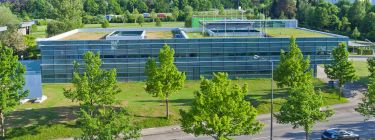
A Program for Culture at the Crossroads
Prof. Dr. Miachael Resch, Director of HLRS High-Performance Computing Center, Stuttgart; Prof. Dr. José Teixeira Coelho Netto, Curator at Media Solution Center, Baden-Württemberg; Matthias Hauser, General Manager at Media Solution Center, Stuttgart
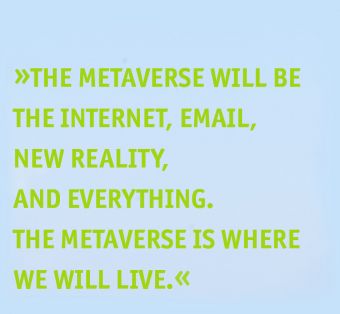
A Program for Culture at the Crossroads
Mission accomplished?
The world is about to enter the Metaverse, says Mark Zuckerberg. The Metaverse, in his vision—or in his eagerness for more power and wealth disguised as a noble contribution to humanity—is a virtual place where we work, have fun, meet friends, watch movies, play games, and, most of all, consume. The Metaverse will be the internet, email, new reality, and everything. The Metaverse is where we will live. Monika Bickert, Metaverse’s vice-president in charge of policy content, wrote an article for Le Monde on November 10, 2021, in which she stressed that the Metaverse is a new kind of life.Facebook, Mark Zuckerberg’s previous company name that he is now trying to sweep under the rug, claims to have 2.9 billion users in 2021. It may be so. If it is, the foundations for Zuckerberg’s Metaverse have already been laid—in a very short time, considering Facebook’s founding in 2004. The Metaverse is not here yet, but Facebook is—and Facebook is the dress rehearsal for the Metaverse.
Picture above: High-Performance Computing Center HLRS University of Stuttgart, Copyright: Boris Lehner for HLRS
Picture left:
The impending Metaverse—as the successor of Facebook in a family that houses its siblings Twitter, Instagram and TikTok—is not an index of a recent crisis: it configures a dynamic that has been going on for quite some time now. However, this crisis—or moment of decision, in its etymological meaning—has become acute in the last couple of years. Everywhere voices are warning that either we do something now or humanity may lose its grip on its destiny. The remarkable novel The Machine Stops1, published by E.M.Forster in 1909, was at the time considered to be just a piece of futuristic divertissement. But its depiction of a proto-Metaverse shows all the characteristics Mark Zuckerberg boasts about his project. Forster’s book was a fantastic effort to anticipate a reality in which humanity has been increasingly living since then, with some dramatic peaks in the last couple of years—one of them being the attempt to invade the Capitol on January 6, 2021, to keep Donald Trump in power. Even our contemporary social media is described in 1909 as the „behavior modification empire“.This description is a rather generic, mild, and euphemistic label and could equally apply to the movie industry, the television industry, and much more. Therefore, we prefer to name it more straightforwardly: antisocial media.
As the computer scientist Jaron Lanier, author of Ten Arguments for
Deleting Your Social Media Accounts Right Now (2018), argued, social media is a challenge to humanity just as serious as the greenhouse effect. So, it is appropriate to say that media are responsible for the “greenhouse effect of the mind” based to a large extent on artificial intelligence and its supporting algorithms.
We could better understand the new developments by looking at ourselves, our perceptions, and our ideas about the world around us. The French philosopher and sinologist Francois Jullien has compared Chinese and European views of the world2 (The Propensity of Things: Toward a History of Efficacy in China, 1999). He concludes that our European view of the world is shaped by our looking for an ideal (eidos), aiming at modelling the world such that we can achieve that ideal. As a consequence, we tend to think in models. It seems to be obvious that thinking in models has led us to describe the world in mathematical terms. This method was feasible as long as that description did not spin out of control. With the advent of the computer, our mathematical description of the world has become the dominant (for some the only) and most efficient description of the world. Artificial Intelligence now aims to turn a de-scription into a pre-scription to use our mathematical models to control our world better.
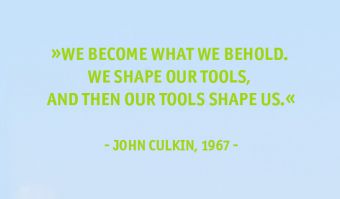
Several human hopes and desires are driving this prescription. Mathematical models avoid ambiguity by helping us to identify specific solutions in an ambiguous world. We can further claim that our solutions are not distorted by human intervention, with mathematical algorithms executed by a flawless machine—only experts understand that computers are neither flawless nor do they operate without human intervention. The idea of excluding human error allows us to pretend that our digitally created realities based on mathematical models are just—devoid of any prejudice and human flaws. In addition to this idea of an artificially created intelligence, the vision of creating life without resorting to nature is tempting, especially if we believe that this is a species created only from human minds and exempt from all the flaws that come with the dirty and mortal nature that surrounds us.
Our enthusiasm for our creations leads us to ignore the warning issued by John Culkin in 1967: „We become what we behold. We shape our tools, and then our tools shape us.“ Taking the models we create for reality has always been the danger of our model-based approach
to the world. Unfortunately, with the computing power in our most current systems, these models get a life of their own and start to spin out of control. This fact itself is a reason to reflect on our understanding of the digital world. Nevertheless, we see disturbing developments that point to human beings‘ abuse of digital technologies beyond that.
After all, Jaron Lanier may have pushed too hard when he called people to delete their „antisocial“ media accounts. He should have stopped short of throwing away the baby with the bathwater. Were it not for the digital tools, to mention one specific event—the ongoing Covid 19 pandemic—the disaster might have been even more extensive. However, his warning is most welcome.
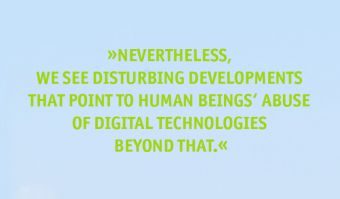
A Program to Address the Situation
If there is still time to remedy this situation, the solution lies in the complete understanding of the meaning of the term “antisocial media” and, in a broader sense, of eCulture. „Understand in order to control,” warned Ludvig Wittgenstein. Humanity must understand eCulture, or eCulture will completely control humanity. Of course, that has always been the issue with every new technology, be it the horseless vehicle, photography, movies, radio, or television. However, none of these innovations compares with the overwhelming power and ubiquitous presence of the antisocial media and artificial intelligence, which have been developing in eCulture—probably the final cultural utopia. Of course, a utopia may be a dystopia or a utopia—that is up to humanity to decide. In order to contribute to the effort towards a utopian eCulture, the Media Solution Center (MSC) has developed the „Reach“ project aiming to promote the understanding of eCulture in as many fields as possible—in the arts, culture, economy, social behaviour—and to create the conditions for eCulture to become a fundamental tool to the advancement of knowledge in a way that promotes civilisation. eCulture has the potential to achieve this goal if humanity can control it. This would be a renaissance.
MSC’s major all-encompassing step is the promotion of the necessary merging between the Humanities (understood as a general umbrella term covering philosophy, the arts, and the disciplines that study the different aspects of human society and its culture) and the Sciences. We have been talking about interdisciplinarity at least since the mid-20th century. Now it is not a question of opting for interdisciplinarity anymore: it has become imperative. A single initiative will not solve a crisis like the one we have experienced in the last couple of years.
If it has been possible for humanity to get an image of the M87* black hole fifty-three million light-years away from Earth, it is because eight observatories scattered all over the Earth convened to transform themselves into one vast and integrated telescope the size of this planet.3 It will take an effort of the same magnitude, probably even more extensive, to confront the Metaverse.
The 21st century saw the emergence of a generation native to eCulture, compared to the older generations for whom it was a novelty. The aggregate power of this new generation provides a unique tool in the forging of a new age for humanity. The MSC wants to be an active part in the effort to avoid a situation in which the limitations of artificial intelligence and its algorithms become the limits of humanity.
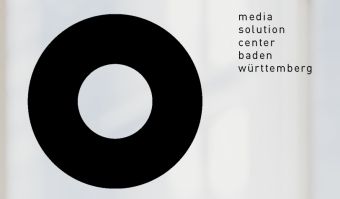
MSC has therefore structured its Reach Project as the Research and Creation Center for eCulture and the Humanities. The Center intends to develop a program building a bridge over the ever-growing gap between the Humanities and science and technology. This distancing between the two fields has become widely addressed since the beginning of the 20th century—the conflict between the „two cultures” C.P. Snow described in his 1959 eponymous book.4
Picture left: Logo Media Solution Center Baden-Württemberg
Mission One: Converging Humanities and Science
MSC’s Reach project’s first mission is to support and amplify the conversation between the Humanities and the „hard“ sciences. The Reach Project will not directly address science and digital technology. It will also investigate eCulture as the medium to which science, digital technology, and the Humanities converge to create a distinctive culture, a culture that can face the Metaverse. MSC’s principal arm for that is its academic, nonprofit research program dedicated to today’s culture’s complex and multidisciplinary study. This program includes contributions from the most diversified areas, including physics, neurosciences, biology, the study of social systems, and other complex approaches to the way we are living today surrounded by the internet and all forms of virtual representations. This program will consist of lectures, colloquia, seminars, and short duration courses oriented by the just-in-time principle, as opposed to the just-in-case principle.
Mission Two: CreativeLab
Reach’s second mission—where MSC leaves the academic field to tackle the thing itself—is to support young professionals in their projects leading to the creation of start-ups involved in using the current cutting-edge technology, especially artificial intelligence. This support will come through Reach’s CreativeLab, which will host collectives organised around professional projects requiring cutting-edge studies and all the material and economic support they may need, either in campus residencies or virtually. Creativity plus an understanding of what is going on is the underpinning of the CreativeLab.
Mission Three: Observatory of eCulture
Reach’s third mission is creating an Observatory of eCulture that will gather information about all things related to eCulture, from the internet to robotics to the social impacts of digital technology. Data—especially Big Data—have already been identified as the new source of wealth and power. However, there is barely any research by any creative initiative that does not depend on a well-organized information centre resulting from constant, attentive, and active observation of the world. Therefore, identifying, storing, and analysing the gathered information has become necessary.Reach’s three missions are enabled by the Network the MSC is part of: The HLRS, the High-Performance Computing Center with its supercomputer, the HdM Stuttgart Media University, with its highly specialised faculties, and the Core-Partner ZKM, Center of Art and Media Karlsruhe. These are unique assets not found elsewhere. As a result, MSC has the concept, the material means, and the people to concisely drive this project into reality. And it will—and it will thus be a focal point for this Renaissance in the Making.
Where: at the High-Performance Computing Center HLRS University of Stuttgart, directed by Prof. Dr. Michael Resch, and the Media Solution Center MSC, directed by Matthias Hauser. Duration: as long as it takes.
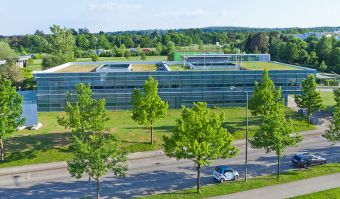
Picture above: High-Performance Computing Center HLRS University of Stuttgart, Copyright: Boris Lehner for HLRS
References
1 E.M. Foster, The machine stops, Penguin Classics, 2011
2 Francois Jullien, The Propensity of Things: Toward a History of Efficacy in China, Merve, 1999
3 The Astrophysical Journal 901:67, September 20, 2020
4 C.P. Snow, The Two Cultures, 1959.
Matthias Hauser
Matthias Hauser has had extensive experience managing the dialogue between Art and Technology. He received a formal education in music. During his professional career as a musician, Matthias Hauser understood that art is a comprehensive system with specific artistic languages in dialogue. His experience in Art Education as a professor of violoncello acquainted him with introducing people to art – which is the base of his arts management practice.As director of an art gallery in La Coruña and Stuttgart for fifteen years, Matthias developed special projects involving art and cutting edge technology for Brands such as Rolls Royce during the 31 edition of Sao Paulo’s Biennial, Gallery Weekend Berlin, and Multimedia Art Dialogues at the Main Palais, Frankfurt. In 2019 Matthias was appointed as the first director of the Media Solution Center in Stuttgart (MSC) – an extension of the High Computing Center (HLRS) at the University of Stuttgart. The MSC bridges between HLRS’s computing capacity — one of the largest high-performance computers– and the needs of industries, corporations, research centers, art institutions, and social organizations in computing resources. Matthias Hauser will face the challenge of creating the conditions for individuals, collectives, and institutions to realize their goals.
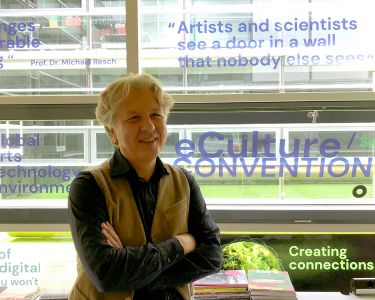
Prof. Dr. Michael Resch
Prof. Michael Resch is the director of the German National Supercomputing Center HLRS and the director of the Institute for High Performance Computing at the University of Stuttgart He is a member of the board of trustees of the Center for Art and Media Karlsruhe (ZKM) and an advisory member of the board of trustees of the German Schiller Association. He is a member of the University Council of the University of Stuttgart and a member of the consulting committee of the Film Akademie Ludwigsburg. He was a Co-founder of the Media Solution Center in 2018 and a Co-founder of the Automotive Solution Center Stuttgart in 2008. Prof. Resch was awarded an honorary professorship in 2014 and an honorary doctoral degree in 2011 by the Russian Academy of Science and an honorary doctoral degree in 2009 by the Donezk National Technical University. Michael Resch is a PI since 2007 in the German clusters of excellence for “Simulation Technology” (2007 – 2018) and “Data-Integrated Simulation Technology” (2019 – 2025) as part of the German Initiative for Excellence in Research. Michael Resch holds a Dipl.-Ing. (MSc) in Technical Mathematics (Technical University of Graz/Austria) and a PhD in Engineering from the University of Stuttgart.
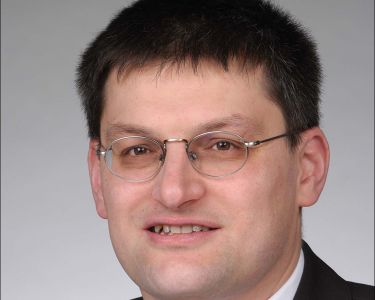
Prof. Dr. José Teixeira Coelho Netto
Dr. Teixeira Coelho is the coordinator of a research group on Computational Cultures and Humanities at the Institute of Advanced Studies of the University of São Paulo, from which he received in 2015 the honorific title of Professor Emeritus for his accomplishments in research, teaching and extension services to the community. He was the director of the Museum of Contemporary Art of São Paulo, which has the most important collection of modern art in Brazil, and the chief curator of Masp – São Paulo Art Museum, a major institution of art in the South Hemisphere. Formerly professor at the Institute of Architecture of University Mackenzie in São Paulo, he has been invited for a number of universities around the world and was granted fellowships from the Fulbright Foundation, Rockefeller Foundation, Japan Foundation and the São Paulo Foundation for the Support of Science, among others. He has published a large number of books on art, culture and cultural policy, among them eCulture, The Final Utopia (2020) and Signs and Wonders (in the Digital Age), 2021. He was also awarded a Portugal Telecom Prize for Literature in Portuguese for his novel História Natural da Ditadura. Since 2020, he has held the position of curator at the MSC.
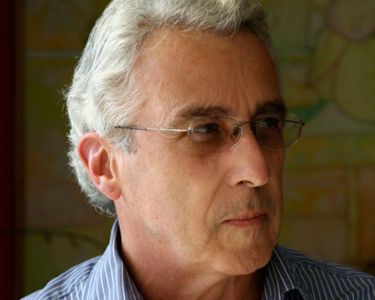

Intellectual Property and the Industry Commons
Industry Commons Foundation
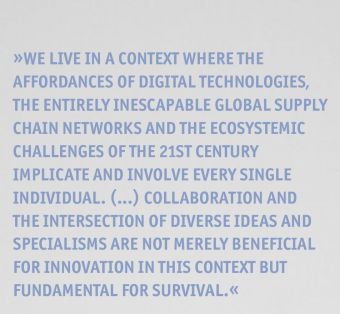
Intellectual Property and the Industry Commons: Unlocking the Renaissance
Recognised as a major influence on economists, Leonard Reed’s 1958 essay ‚I, Pencil’ demonstrated that the invention of even the simplest of objects is the result of mass collaboration. A pencil is made by loggers, graphite miners and factory workers. Its form is predicated on the invention and widespread adoption of writing and drawing, and it requires an ecosystem of other technologies from pads of paper to marketing and distribution networks. The workers involved need to eat food and travel to work, and this all takes place within an elaborate economic and social web.
As interwoven, interdependent, cross-disciplinary and intricate as those systems were, Reed could not have foreseen the world to come. The extent to which the processes, raw materials and interconnected networks would become exponentially and globally more complex sixty or so years later would have been absolutely unthinkable. What had been the paradigm-shifting impact of Reed’s observation now needs to happen again at the next order of magnitude. We live in a context where the affordances of digital technologies, the entirely inescapable global supply chain networks and the ecosystemic challenges of the 21st century implicate and involve every single individual. We can no longer extricate ourselves from those global systems. Collaboration and the intersection of diverse ideas and specialisms are not merely beneficial for innovation in this context but fundamental for survival.
These intertwined framework conditions and cross-domain technological affordances lend themselves to the design of new supporting frameworks that are more inclusive and equitable. For the first time ever, the acceleration of industrial digitalisation provides an opportunity to build radical or disruptive innovation on top of existing intellectual property (IP), in a system that is fully trackable and accountable for all involved. Our tests conducted in the past five years2 demonstrate that ensuring traceability and attribution creates a powerful incentive to share data and other assets across fields, sectors and industries, helping humanity embrace innovation with greater motivation and efficacy than ever before.
Intellectual Property is a broad, complex and discursive area of study, subject to critique as a preventer of innovation and as a barrier to the creation of new ideas. Its fundamental condition as a category of property law has led to its status as a domain of guarded ownership, complicated routes to permission and a punitive legal minefield with steep costs for infringement – intentional or otherwise. The default position for access to industry IP has long been a blanket ‘no’ except under exceptional, usually expensive circumstances.

IP regulation has not followed the evolution of IP value creation.
In his ongoing quest to find out more about how people create and innovate, Professor Brian Uzzi, a professor of leadership at the Kellogg School of Management, Northwestern University, and his team, measured the citations of every paper available in the Web Of Science, a repository of some 30 million scientific papers dating from the early 1900s to the present day.3 The articles with the most significant impact, he discovered, were collaborative. “Since 1950, teams have become more prevalent as a production mechanism,” he said in an interview for the BBC podcast Sideways.4 “Teams are getting bigger over time, [and] they are three to four times more likely to write a hit paper or produce a hit patent than individuals.”
He also noted that these teams were primarily composed of specialists from different disciplines: “Biologists working with economists and anthropologists, or historians working with big data experts and ethnographers.” This meeting of minds across boundaries is known as recombinant innovation, and it has an impressive track record of helping humanity make significant strides forward.
Fear of sharing IP, however, is deeply embedded. Sandra Vengadasalam of the Max Planck Digital Library describes how researchers feel about the issue: “If you ask them ‘What are you afraid of?’ – and it doesn’t matter which discipline – it’s ‘Oh, I’m super afraid to get scooped’.” In other words, there is strong concern that colleagues or competitors will steal a march on you and publish first. “It starts when you want to share your PowerPoint presentation, some pictures of your last microscopic data, whatever,” she continues. “There’s always the fear of ‘Okay, what can I give out? And what about my intellectual property?’”5
In the corporate world, the issue of IP is broad, complex, and carries significant responsibility for erecting barriers to ideas and holding back innovation. Indeed, amongst the closely guarded IP locked away by industry lies a substantial proportion of the estimated $100bn value of data sharing. But this isn’t simply an issue of trust. There can be problems relating to interoperability and conflicting standards, which make sharing difficult, despite the obvious benefits of overcoming them.
Take the example of driverless vehicle data. In 2017, Chris Ballinger, Toyota Research Institute’s CFO and Director of Mobility Services, estimated that it would take ten years for any single company working in the field to collate all the information they need about roads and infrastructure.6 That information is almost instinctively placed under lock and key as it is collected. But if the data is shared between, say, nine other competitors, it could be gathered in a single year, allowing much more rapid progress to market. By pooling information and standardising interoperability, everyone would, metaphorically speaking, be using the same railway tracks.
To increase the value of IP, we need to operate on common railway tracks.
In his book How Innovation Works,7 Matt Ridley lists endeavours for which the free sharing of ideas was pivotal: “…the Dutch East India company’s cargo ship, the Fluyt; Holland’s windmills; Lyons’ silk industry; crop rotation in England; Lancashire’s cotton spinning; America’s engines for steamboats; Viennese furniture; Massachusetts paper makers…” He also notes: “It was the flowering of societies, clubs and mechanics’ institutes that gave Britain its lead in the Industrial Revolution.”
Just as societies and clubs provided meeting grounds and shared points of cultural connection, it is necessary to now share spaces of common understanding with culture as a pivotal element, and creativity as both facilitator and the reason for coming together. For the past decade, MTF Labs has demonstrated that music provides that shared cultural touchpoint, common ground, creative spark and “social glue” that connects otherwise divergent minds.
Music thrives on the melding of diverse perspectives. For instance, the ongoing global success of the Swedish songwriter Max Martin has relied on an extraordinary list of collaborators: death metal artists, classically trained pianists, musicians from Barbados, India and beyond. This has contributed to Sweden being the number one country in the World for music exports per capita.8 Writer and thought-leader Matthew Syed argues that pop music has become the “recombinatorial art form par excellence,” a product of “the constant search for the sweet spot of musical collaboration.”
Crucially, those collaborations are supported by an advanced IP framework, thanks to more than a decade of work by the music industry to develop platform alignment for metadata. That industry is also starting to adopt systems for rights registration at the point of creation, such as Sweden’s Session, now used by Spotify and YouTube,9 which can unlock hundreds more millions of euros in untapped value. The Industry Commons IP Framework Study (2021)10 identified several cross-domain use cases where this kind of approach to IP management is already speeding up time to market. Equally, expanding one’s sphere of influence may uncover unexpected markets. A study of the expansion of the European Open Science Cloud revealed that its FAIR system of data sharing (findable, accessible, interoperable and reusable) turns into a system of data valorisation when deployed by commercial organisations.11
The unlocking of an interoperable Industry Commons of data-driven assets also provides creative innovators with the opportunity to generate new ideas that include intellectual property owned by others. Placing a wealth of existing research, R&D, products, designs and creative works into the hands of creators radically accelerates the innovation process, provides rapid knowledge transfer across domains and carries the potential for cross-sectoral and hybrid projects that could not have taken place within an individual industry vertical or organisation.
Pablo Garcia Tello, Section Head of New Projects and Initiatives at CERN, calls this “The New Alexandria”, inspired by the colossal library of the ancient world, which contained more than 400,000 scrolls and was available to anyone and everyone. Whatever you may take from The New Alexandria, he says, the rule is that you give something back. This would, in his words, “democratise knowledge and innovation while giving credit and recognition to the creators.” Such an innovation ecosystem could, he believes, help to integrate cross-disciplinary innovation and entrepreneurship.
Christer Gustafsson, Professor of Sustainable Management of Cultural Heritage at Uppsala University, believes the innovation that such systems could unlock goes beyond mere economic value: “My focus today is to more-or-less completely change the mindset from starting with this ‘protection oriented’ idea… It could be the change from an industrial society to a post-industrial society.”

IP valorisation is dominated by systemic inequality.
Patenting is still by far the most commonly used system of IP valorisation, even though it still carries the signs of the era that launched it, when married women were not allowed to own any kind of property:
Women do not get a fair share when it comes to patenting and are far less likely to own patents. This disparity is in part because of not only the inherent biases in science and technology and in the patent system itself, but also because of the high costs of even applying for patents. […] Patents are a glaring exception to the unregistered protections provided in other areas of intellectual property, which are more egalitarian in design.12
Currently, European patent granting procedures are expensive, slow (three to five years, on average), burdened with obscure legal terminology and fraught with problems relating to the definition of ideas and similarity to other patents. IP Screener13 makes a powerful case for making all patents findable with AI-assisted technologies, so independent inventors can affordably source and track existing inventions using plain language, build their knowledge from existing inventions and avoid infringing on protected IP.
To the minefield of gender and economic inequality for independent inventors, data-driven systems introduce additional challenges for IP management. Bias inherent in data sets, problems with data provenance verification, and risks of negative impacts on social behaviours have prompted industries to increase the demand for testing of new data-driven industrial applications in low-risk “living labs” environments. This allows them to capture unexpected outcomes from novel applications of frontier technologies before deploying them at scale. The core assets of manufacturing and industrial production have all become digitised, and all industries are now data industries. As data becomes a critical raw material and crossing streams becomes much easier, the risks to widespread bias become all the greater.
Allowing data provenance to remain in the black box presents an enormous risk for society. While this points to a growing need for new regulation and standards for data markets, it also enables new economies and value systems, creating a major new economic paradigm for society. Solving how IP attribution and provenance work in data markets can result in an explosion of new types of innovation, and as data becomes central to every industry vertical, tracking innovation enables unprecedented exploitation of diverse global market segments.
To move the paradigmatic shift of Reed’s “I, Pencil” to the next order of magnitude, a shared commons of trackable, traceable and easily licensable assets must be provided as fuel for a creative and economic renaissance enabled by an explosion of human ingenuity and motivated by the 21st Century’s ecosystemic challenges. We cannot separate ourselves from those ecosystems – or from each other. Whether a pencil, an AI platform, a novel musical instrument or an RNA vaccine, innovation is a major enabler for people to benefit from each other’s contributions. This is what society is for – or should be. It is, therefore, necessary to embrace radical inclusion and stop thinking in terms of ourselves as separate entities with individual characteristics, capabilities and (self-)interests. Instead, let us start with the question: Where do we converge?
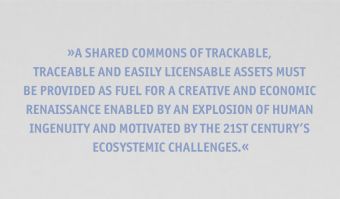
REFERENCES
1 According to Harvard Business School Professor Gary Pisano, incremental innovation for existing competencies and business models is routine; radical innovation builds new competencies for an existing business model; disruptive innovation proposes a new business model for existing competencies; and architectural innovation introduces both new competencies and business models. (Pisano, G. 2019, Creative Construction: the DNA of Sustained Innovation, PublicAffairs).
2 Experiments with creative innovation communities in partnership with blockchain technology companies and other decentralised platforms at MTF Labs in Helsinki, have demonstrated that it’s possible to establish new ways of recording, tracking, and tracing intellectual property live, in real-time, at the point of creation, using distributed ledger technology. These ideas have been codified and scaled up in the Industry Commons IP Framework study (2021).
3 https://insight.kellogg.northwestern.edu/article/science_as_team_sport/
6 Fortune Magazine, 22 May 2017: http://fortune.com/2017/05/22/toyota-mit-blockchain-driverless-cars/
7 Ridley, M., 2020. How Innovation Works: and why it flourishes in freedom, Harper, NY
8 Export Music Sweden, 2020: https://report2020.exms.org/
9 https://musically.com/2021/11/18/rights-data-startup-session-gets-1m-from-spotify-and-youtube/
10 https://industrycommons.net/ip-framework.pdf
12 Marcowitz-Bitton, Miriam; Kaplan, Yotam and Michiko Morris, Emily (2020). Unregistered Patents & Gender Equality. Harvard Journal of Law & Gender.
Michela Magas
Michela Magas is a designer who bridges the worlds of science and art, design and technology, academic research and industry with a track record of over 25 years of innovation. She is innovation advisor to the European Commission and the G7 leaders, member of President von der Leyen’s High Level Round Table for the New European Bauhaus, and member of the Advisory Board of CERN IdeaSquare (ISAB-G). In 2017 she was the first woman from the creative industries to be awarded European Woman Innovator, and in 2016 she was presented with an Innovation Luminary Award for Creative Innovation by the European Commission and Intel Labs Europe. She created the concept of the Industry Commons which has galvanised European industry around cross-domain data interoperability. She is the Founder and CEO of Stockholm-based MTF Labs, a global community platform of around 8000 creative innovators and scientific researchers, which provides a test case for innovation in areas as diverse as neuroscience, forestry and microcomputing. For 20 years she ran Stromatolite Design Lab in London creating design futures with global clients such as Apple, Nike and Nokia.
Picture © Nebojsa Babic square

Andrew Dubber
Andrew Dubber is is an author, academic, public speaker and broadcaster, Director of MTF Labs, and Steering Board Member of the Industry Commons Foundation. He has written extensively on the digital transition, cultural identity in popular music, and social innovation in the cultural sector, including Radio in the Digital Age (Polity, 2013) and Understanding the Music Industries (Sage, 2012). He is the manager of Erasmus+ projects about STEAM education and is an active participant in EU Horizon projects about innovation and the Creative Industries. Until 2015, Dubber was UK Arts and Humanities Research Council Knowledge Transfer Fellow and Professor of Music Industry Innovation at Birmingham City University’s Centre for Media and Cultural Research. As an academic he led and contributed to practice-based research and Knowledge Exchange projects focusing on digital mediation, intellectual property, the creation of meaning from media objects within social and cultural networks, and innovation for social change. As an early adopter of new media platforms, Dubber has been blogging since 2002 and podcasting since 2004.
Picture © Michela Magas
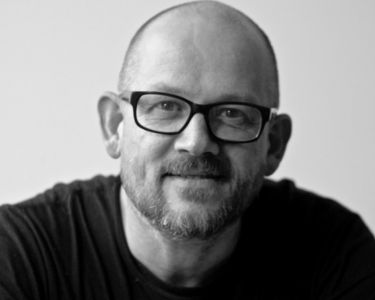
Rhodri Marsden
Rhodri Marsden is a writer and musician based in the UK. He was the technology columnist for The Independent newspaper from 2006 until 2016, and subsequently took on that role for The National, a leading English language paper based in the UAE. His other writing, on subjects ranging from male-pattern baldness to amateur perfume makers, have appeared in dozens of publications including The Guardian, i, Daily Telegraph, New Statesman, The Times, Glamour and Cosmopolitan. His annual fundraising efforts for the homeless every Christmas Eve on Twitter provided the catalyst for his most recent book, A Very British Christmas. A sought-after producer and musical director, he had an unlikely top 20 iTunes hit in 2019 with a disco album on the subject of Brexit, and he continues to perform as part of the much-loved pop group Scritti Politti.
Picture © Laura Ward

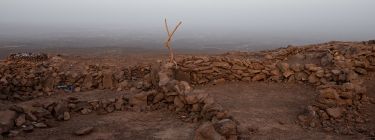
A Culture of Ecology: the 21st Century Renaissance
Fellow at King’s College London
and The National Gallery X, London
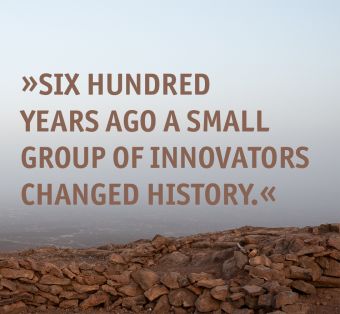
A Culture of Ecology: the 21st Century Renaissance
Beauty, epiphany, neurons
Six hundred years ago a small group of innovators changed history. They lived in Italy, and the name of their era, the Renaissance, is delightfully compact. It means rebirth, renewal and the emergence of new character. Europe has experienced more than one renaissance, but the Quattrocento occupies a special place in the imagination. The reason is clear. Unlike comparable eras, the Italian Renaissance produced colourful characters who embody wide-ranging achievement: Renaissance people who excelled in the arts, science and engineering. The influence of Filippo Brunelleschi, Leon Battista Alberti and Leonardo da Vinci spread throughout Europe, and they continue to inspire the world. In most eras we discourage polymaths, but we make an exception for Quattrocento genius.
Header photo: View from Erte Ale volcano in Ethiopia
This was a study for the performance installation ›Epiphany: The Cycle of Life.‹ (c) 2015 Ali Hossaini
Photo below: Epiphany: The Cycle of Life
Singer Netsayi and the Young People’s Chorus of New York City perform ›Epiphany: The Cycle of Life‹ at BAM in New York City. (c) 2015 Ali Hossaini
What lessons can we take from the Italian Renaissance? Contemporary society demands specialisation for good reason. Centuries of research, documentation and industrialisation have created deep wells of knowledge. Sub-disciplines of art, science, engineering take long years to master, and they possess cultures that minimise outside influence. Specialisation has brought spectacular results, but perhaps it has limits. One of the Quattrocento’s best-known products, drawing in perspective, offers a case study in the benefits of multidisciplinary training.
Perspective uses optical codes to create realistic images. Painting dominates discussions of it, but the technique’s application goes beyond art. Perspective is a science in its own right, and the ability to represent objects with mathematical accuracy supported a spectrum of progress in Europe. Engineers adapted perspective to develop machines. Anatomy, botany, astronomy and other sciences benefited from accurate drawings. Cartographers created navigational maps, and maritime nations used improved technology to pursue interests at home and abroad. The Renaissance boost to Europe upset the world’s balance of power.
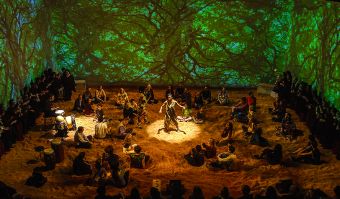
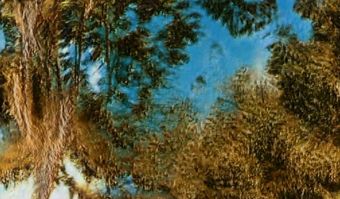
It was not a given that 15th-century Italy would invent perspectival drawing. Euclid codified optics over two thousand years ago, and some scholars argue that the ancient Greeks applied perspective to painting, architecture and theatre. As the name implies, the Renaissance was a rebirth of classical learning. But the Italians of the Quattrocento went further than the ancients, and perspective spread across Europe from Italy, and from Europe to the world. We can describe perspective in one stroke. By applying science to art, and shaping science with art, Renaissance polymaths created the flat panel display.
The beauty of perspectival art reveals the structure of space. Our first guide to perspective is Alberti’s 1435 treatise On Painting, a slender volume which generated incalculable economic value when its techniques were applied to new disciplines. Within a century of Alberti’s treatise, inventors used the camera obscura to automate perspectival drawing, and, within decades, Louis Daguerre and William Henry Fox Talbot industrialised it by inventing photography: drawing with light. To this day, cameras are a locus of innovation, notably in mobile handsets, that charge economic growth. At the same time, the camera is a useful metaphor in digital media. Gaming and animation developers use a ‚camera tool‘ to define the user’s point of view. Today’s 3D design software is one of Alberti’s many heirs.
Here is a curious fact. We perceive the world in three dimensions, and people desire rich immersive experiences. Huge investments have been made in next-generation spatial media platforms since the 1950s. Yet 3D cinema, VR and other forms of immersive media have not replaced flat panel perspective. Investors have waited more than half a century for the transition to spatial media. Why do 600-hundred-year-old techniques—the linear perspective of Brunelleschi, Alberti and da Vinci—continue to dominate creative production?
The stakes are high. When aggregated into XR (Extended Reality), spatial media could transform the Internet into a ‚multiverse‘, a pervasive data environment that merges with the physical world. Nations, corporations and individuals are vying to create the first-generation multiverse, and whoever founds it stands to gain enormous capital through first-mover advantage.
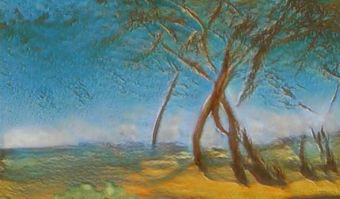
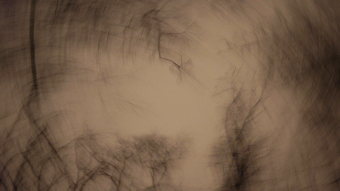
We can speculate on why a spatial multiverse eludes us. Is it because polymaths invented the flat panel display? Renaissance engineers were accomplished artists and scientists; indeed, it is impossible to characterise them with a single word. Their aesthetics embodied intellectual and technical rigour, and they combined innovation with humane values. Consider Brunelleschi’s architectural masterpiece, Il Duomo. Accidents commonly mar construction, but, during Brunelleschi’s management, Florence’s cathedral was erected without a death. Renaissance polymaths studied ancient texts, but they probed nature with tools of their own invention. They envisioned modern science by creating humane environments filled with beautiful objects.
Contrast the Quattrocento with today. Contemporary professionals specialise while the paragons of the Italian Renaissance embodied wide-ranging talent. Perhaps this explains their lasting influence. Drawing in perspective was not instantly popular. Now we take the medium for granted, but 15th-century audiences treated perspective as advanced technology: difficult to learn, marginalised and controversial. Perspective’s utility did not immediately show, and its power to create illusions seemed a gift from Satan. But Renaissance paintings incorporate fine aesthetics. Their masters created paradigms for the media they invented.
Perspective could have been popularised earlier. By the Middle Ages, the science of perspectiva, or optics, was well-established in European universities. After the classical era, Islamic scientists such as Ibn al-Haytham refined it, and mediaeval European painters such as Giotto experimented with spatial illusion. Finally, in the late 14th century, Claudius Ptolemy’s Geography surfaced in Florence’s educated circles. In Geography, Ptolemy describes how to portray the Earth’s sphere on a flat surface, and it is likely that this technique inspired Renaissance experiments. What did Brunelleschi and his colleagues add to the established science of optics? An aesthetic tradition and the desire to draw with scientific accuracy.
Let me speak as an artist. What’s missing from spatial media is a coherent world view. Unlike Renaissance paintings, recent generations of spatial media dropped into a creative and ethical vacuum. Renaissance inventors drew on the ascendence of humane values, and their work embodied visual harmonies that were ethical as well as aesthetic. They were creatures of their time who championed ascendent humanism.
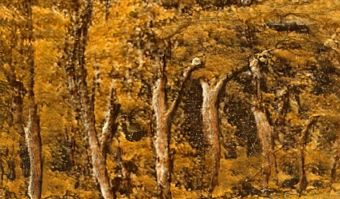
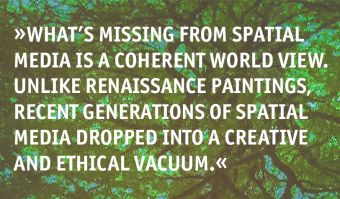
Let me ask again: What lessons can we take from the Renaissance? Aesthetics and contemporary ethics should drive engineering. Technology should express its time; it should express the possibilities and necessities of the moment. Consider another great polymath. In the early 19th century, the Prussian explorer Alexander von Humboldt travelled the world in a quest for grounding principles. Arguably the founder of ecology, von Humboldt published illustrated books that demonstrated interconnections among the physical world, the biological environment and human interventions. Though celebrated while alive, von Humboldt’s star faded and his holistic, interdisciplinary theories were replaced by specialisation and linear causality.
Humanity stands at a precipice, and creative industry is both problem and solution. Our ability to create artificial environments has masked disastrous mismanagement of nature. At the same time, cultural conflicts have paralysed our capacity to act. Why can’t we save ourselves and the innocent creatures who share our planet? The answer turns on the exclusionary cultures we have created—cultures which oppose the ecologically transcendent humanism of Alexander von Humboldt and other ecologists.
The time of art for art’s sake has passed. Likewise, science for the sake of knowledge. Ironically, the culture of purity—the very concept of purity—has created societies antithetical to life. Disciplinary silos, plodding research tracks and philosophy’s retreat from reality into signs maintain this dangerous state. We must engage the world as it is, not as we imagine it. Our paradigms have failed. We need a culture as well as a science of ecology. This is the mission of a 21st-century renaissance.
The people of the 21st century must solve the contradictions caused by specialisation. Paradoxes abound in today’s society. Connections divide rather bind. Governments exhaust a tired planet with economic stimuli. Facts are scorned; forests burn; glaciers melt. To dispel confusion, we must dispel illusions—the illusions created by a fragmented culture that abdicates responsibility for the whole.
Hope lies within the irony of our position. Global infrastructure must be rebuilt, but we need new ways of building that conserve resources. Doing more with less requires new conceptual frameworks. Progress relies on education, innovation and labour—all sources of economic, ethical and aesthetic value. In brief, successfully addressing global crises means growing opportunities. What is the 21st-century renaissance? A context for the cross-disciplinary training, holistic thinking and collective action that creates a sustainable, circular economy: An economy that thrives within nature.
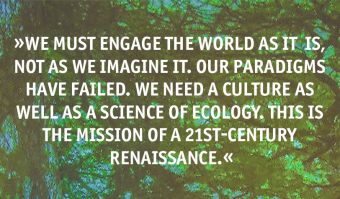
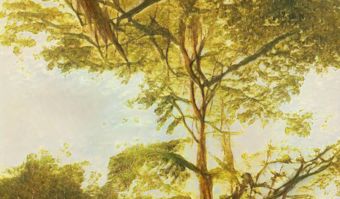
Let us return to spatial media. How should the multiverse evolve? Should it sever humanity from nature, or can it bind society to ecology? Should it enable monopoly, even tyranny, or provide opportunities for all? Markets will determine the multiverse’s form but so will designers. Rather than inventing for its own sake, the multiverse’s engineers need to judge outcomes. Good intentions alone are a recipe for disaster. In the 1990s, I deployed social media into television networks. My goal was to create media for a democratic society. Massive channels, controlled by a few, should be fragmented into capillaries run by individuals. Social media would—I thought—encourage critical thought, dialogue and solidarity.
Here’s another lesson from the Quattrocento. Its polymaths did not separate thinking, making and doing. Nor did they separate ethics, aesthetics and technics. Today holism is deeply unpopular, but I think it is vital for innovators to adopt it. And I argue that holism is vital for producing commercially viable forms of spatial media. The multiverse is not an end in itself: it is the foundation for future generations to innovate. My work in developing standards for ethical design of AI and brain-computer interface has convinced me that media will converge with architecture, urbanism and biology. The next-generation Internet will transcend our current conceptions. Did Alberti imagine streaming media when he wrote On Painting? Imagine the value unleashed by 21st-century infrastructure which supports decades, even centuries, of progress.
Contemporary crises stem from narrow expertise coupled to wishful thinking. Like Quattrocento polymaths, future designers should hold clear aesthetic and ethical values, and they should embed them in their inventions. Alberti, Brunelleschi and da Vinci were humanists, and here they are obsolete. Man is not the measure of things: We need to embrace the biosphere. Like von Humboldt, we should be ecologists who position humanity in nature. A culture of ecology reflects this understanding. It understands the depth of our crisis—the survival of humanity—while driving economic growth.
In a world where inventions are quickly commoditised, culture generates profit. Renaissance polymaths were supported by mecenati, patrons motivated by fame coupled to humanism and social progress. Investors in the New European Renaissance require similar motivations. As Alexander von Humboldt observed, everything is connected. Europe must progress, but European progress should serve, not overrun, the planet.

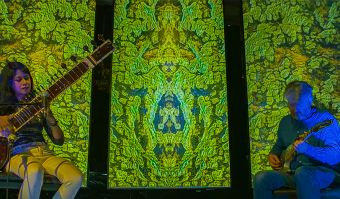
The New European Renaissance could mesh creative industry, science and engineering with an ethos of global awareness. It would preserve the cohesion of European institutions, and it would support the relevance of European industry—and the European project—in a world of superpowers. Let us invest in a 21st-century Renaissance that starts in Europe but benefits every global citizen. Europe’s institutions, the heirs of the mecenati, can generate vast new wealth, and they can also ensure the benefits of prosperity for future generations. What illuminates this path to a bright future? Humanity, technology and ecology coupled to creative imagination.
Photo left: GROUPTHINK: The Internet of Neurons
Neuroscientist Shama Rahman and computer scientist Mick Grierson collaborated with Ali Hossaini, an AI and a cohort of artist-engineers to create GROUPTHINK. Performed at National Gallery X in London and broadcast via Ars Electronica Festival 2021. (c) 2021 Ali Hossaini
More info on the artworks
Epiphany: The Cycle of Life.
https://pantar.com/epiphany/
GROUPTHINK: The Internet of Neurons
https://www.nationalgallery.org.uk/national-gallery-x/groupthink
Sources
All portrayed pictures and paintings in this contribution are (c) Ali Hossaini, 2021.
Dr. Ali Hossaini
Fellow at King’s College London and The National Gallery X, London
Ali Hossaini works at the cutting edge of art, technology and science. Acclaimed by the New York Times, which calls him “a biochemist turned philosopher turned television producer turned visual poet,“ he is noted for cross-disciplinary work that addresses thorny problems. He is a Visiting Senior Research Fellow in the Department of Engineering at King’s College London. In this capacity, he has developed use cases for 5G with Ericsson, studied unequal healthcare outcomes at the Institute of Psychiatry, Psychology and Neuroscience, and assessed the threat from AI with security think tank RUSI. He serves on IEEE committees developing standards for safe AI and brain-computer interface, and he is active as a visual artist, writer and director. In 2019 he co-founded National Gallery X, a program that researches the future of art and audience, where he serves as co-director.
Picture: © Leslie Cummins
